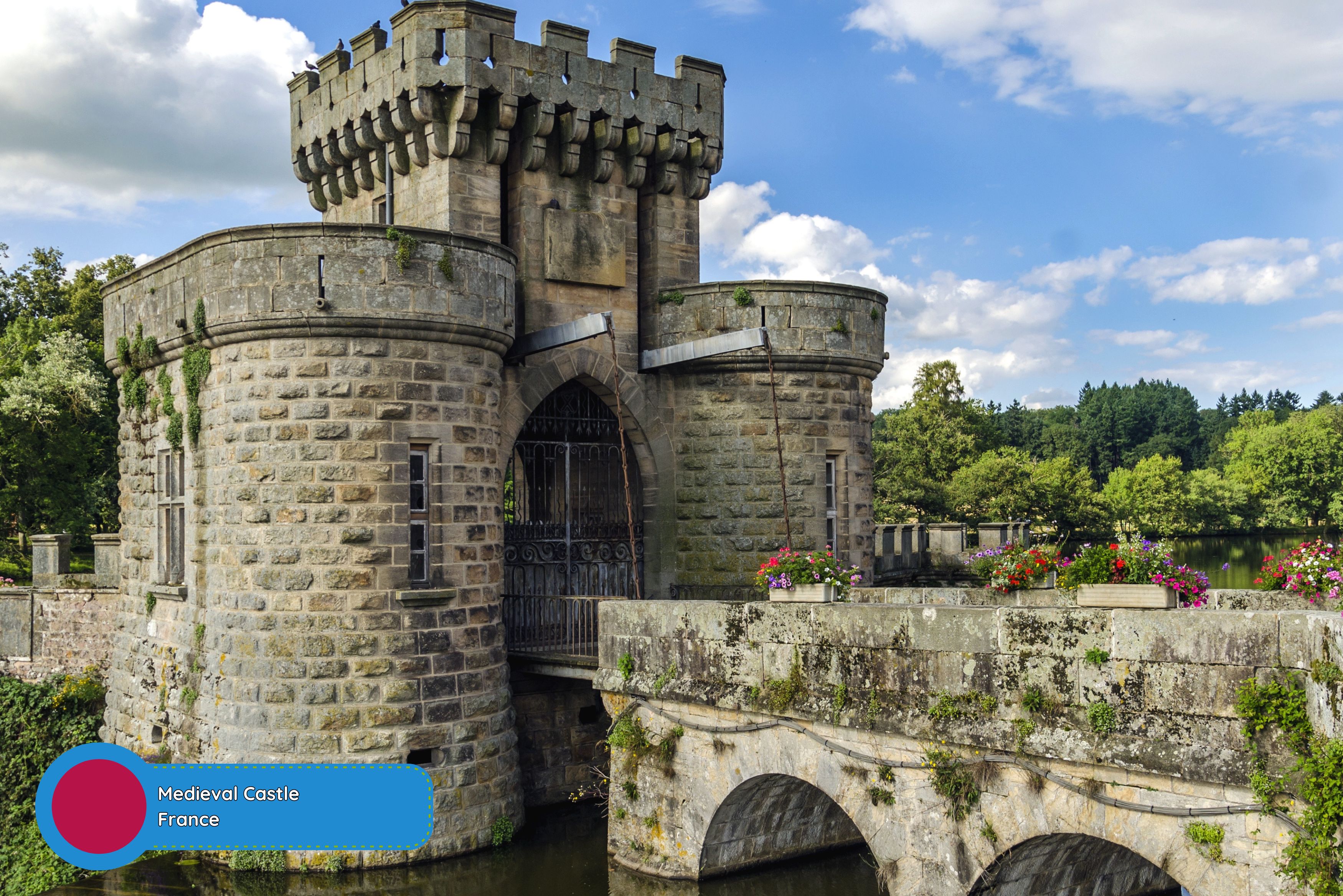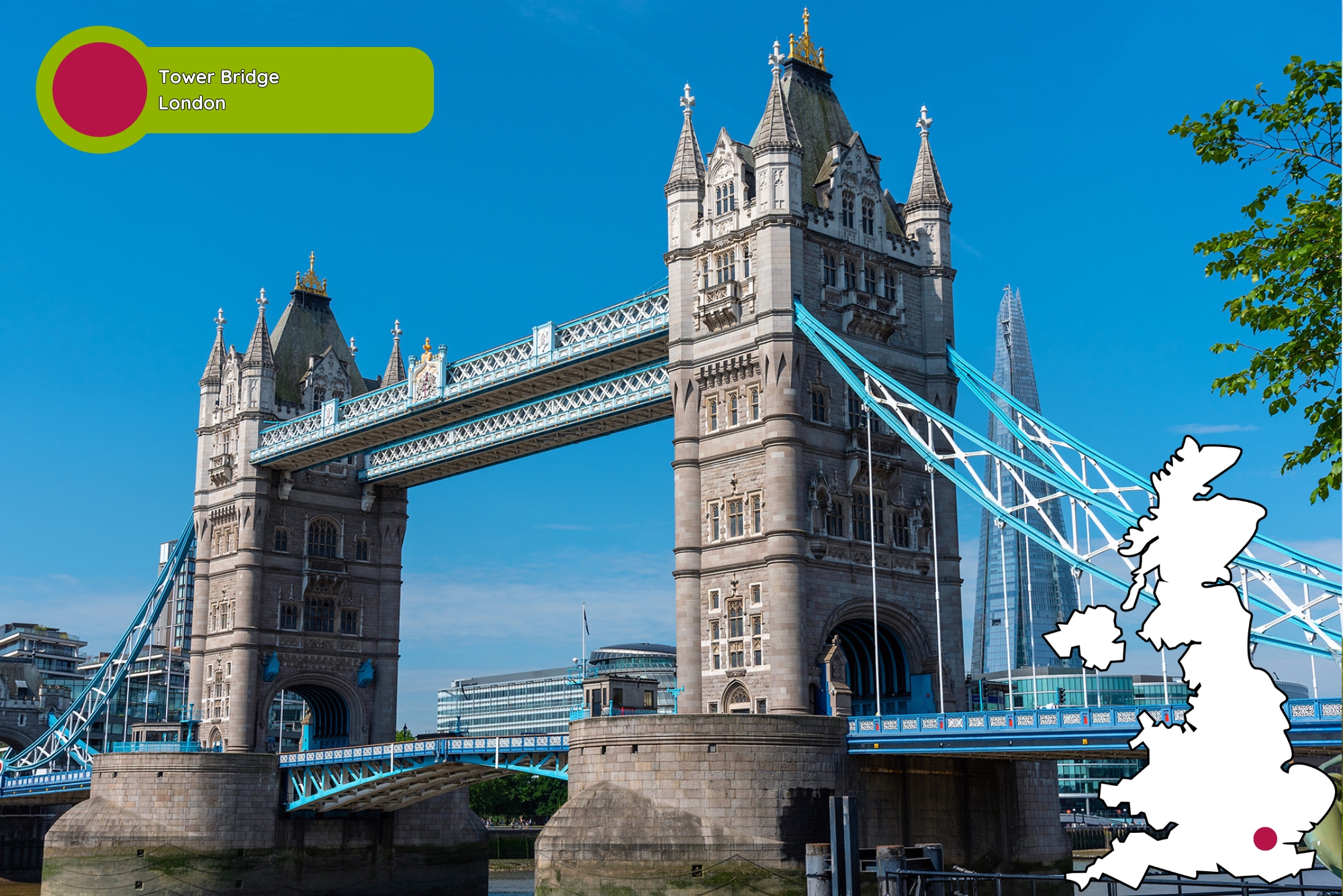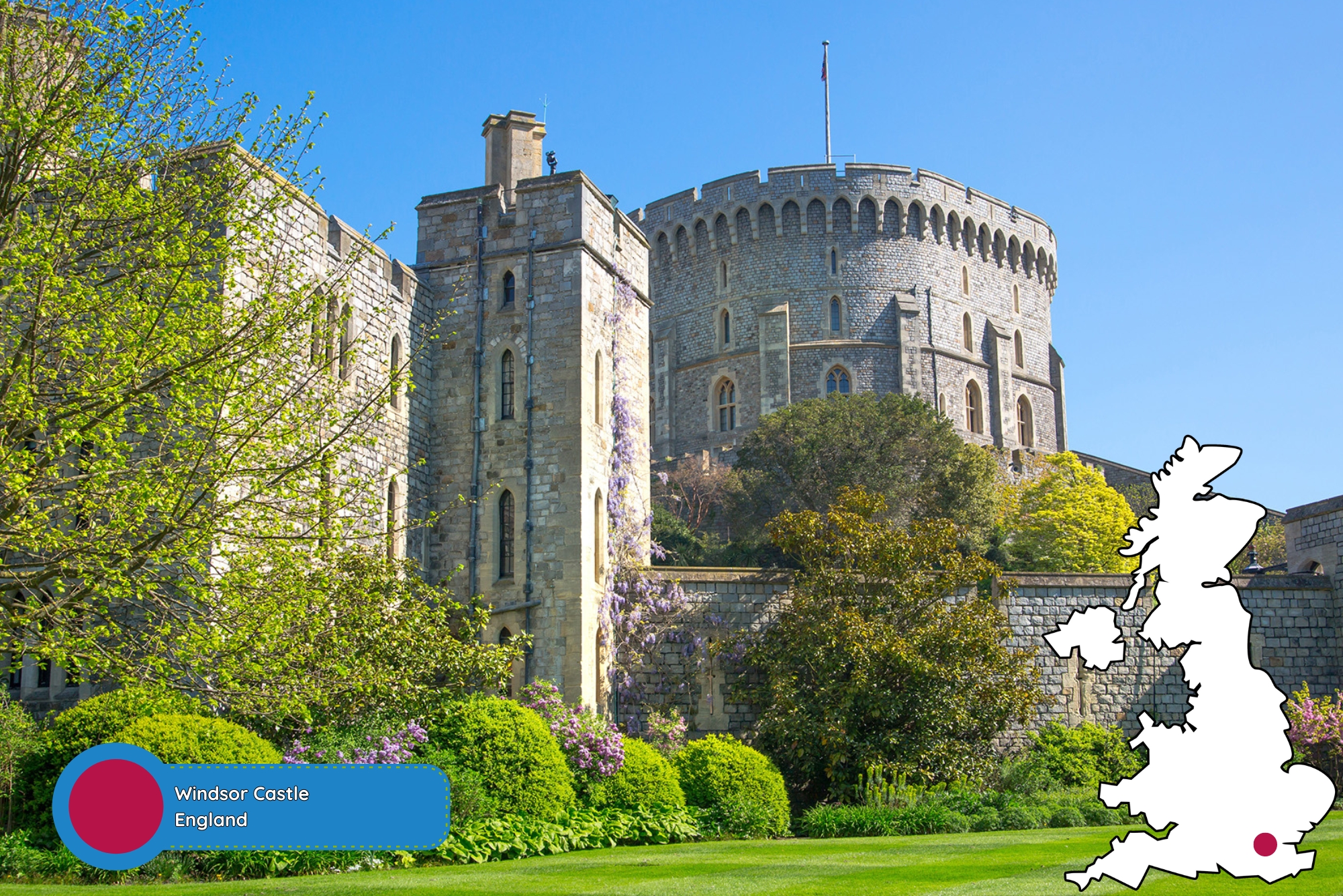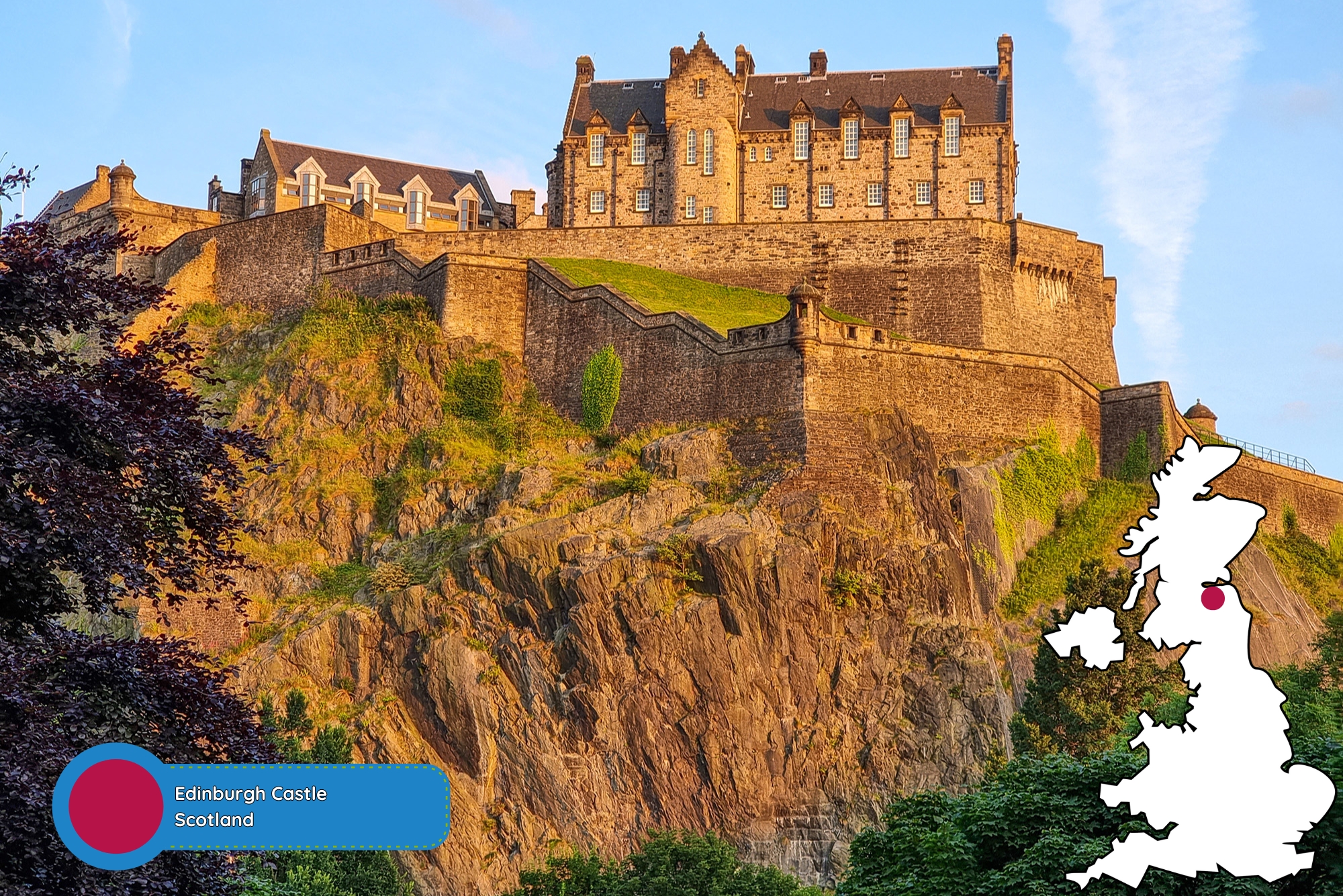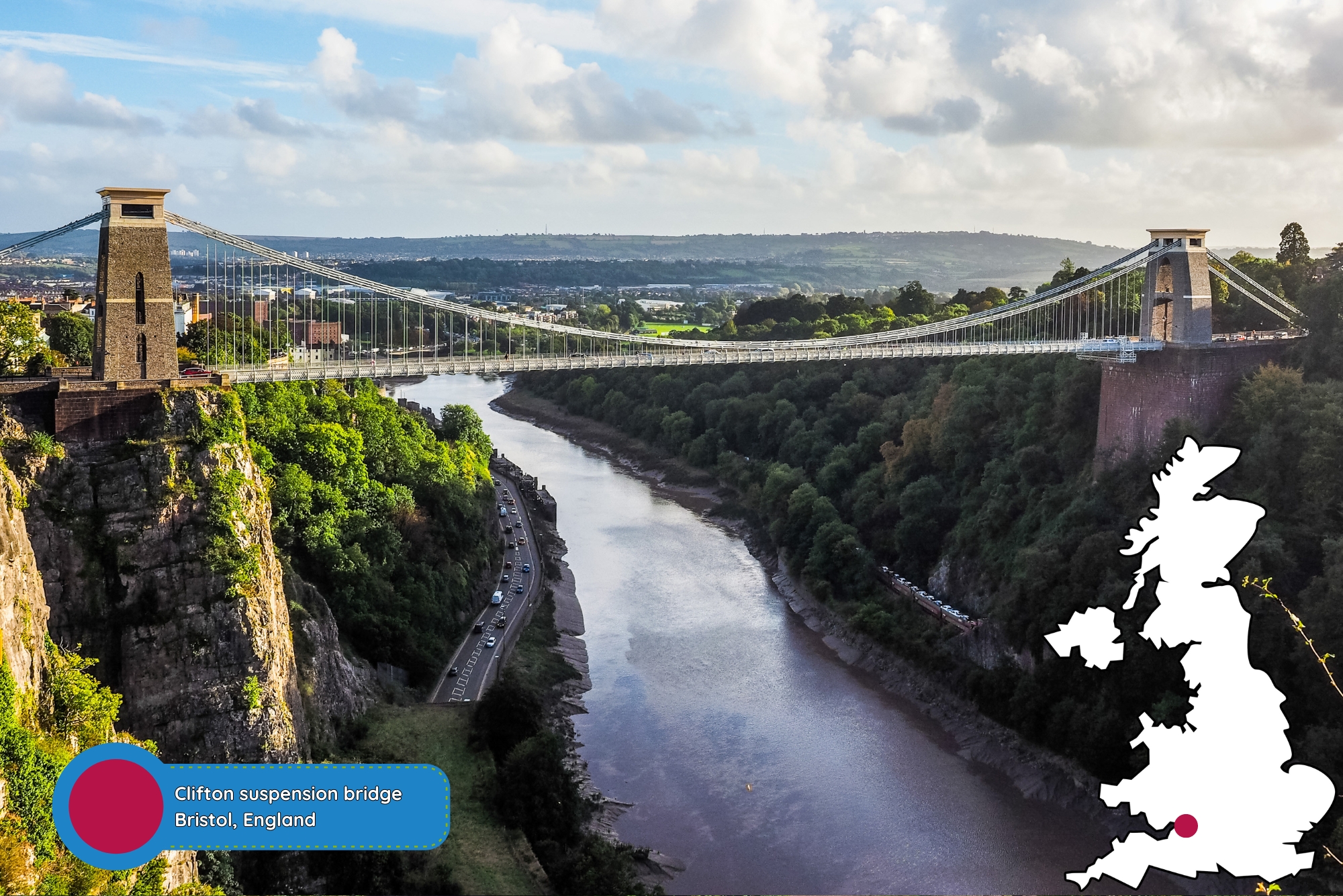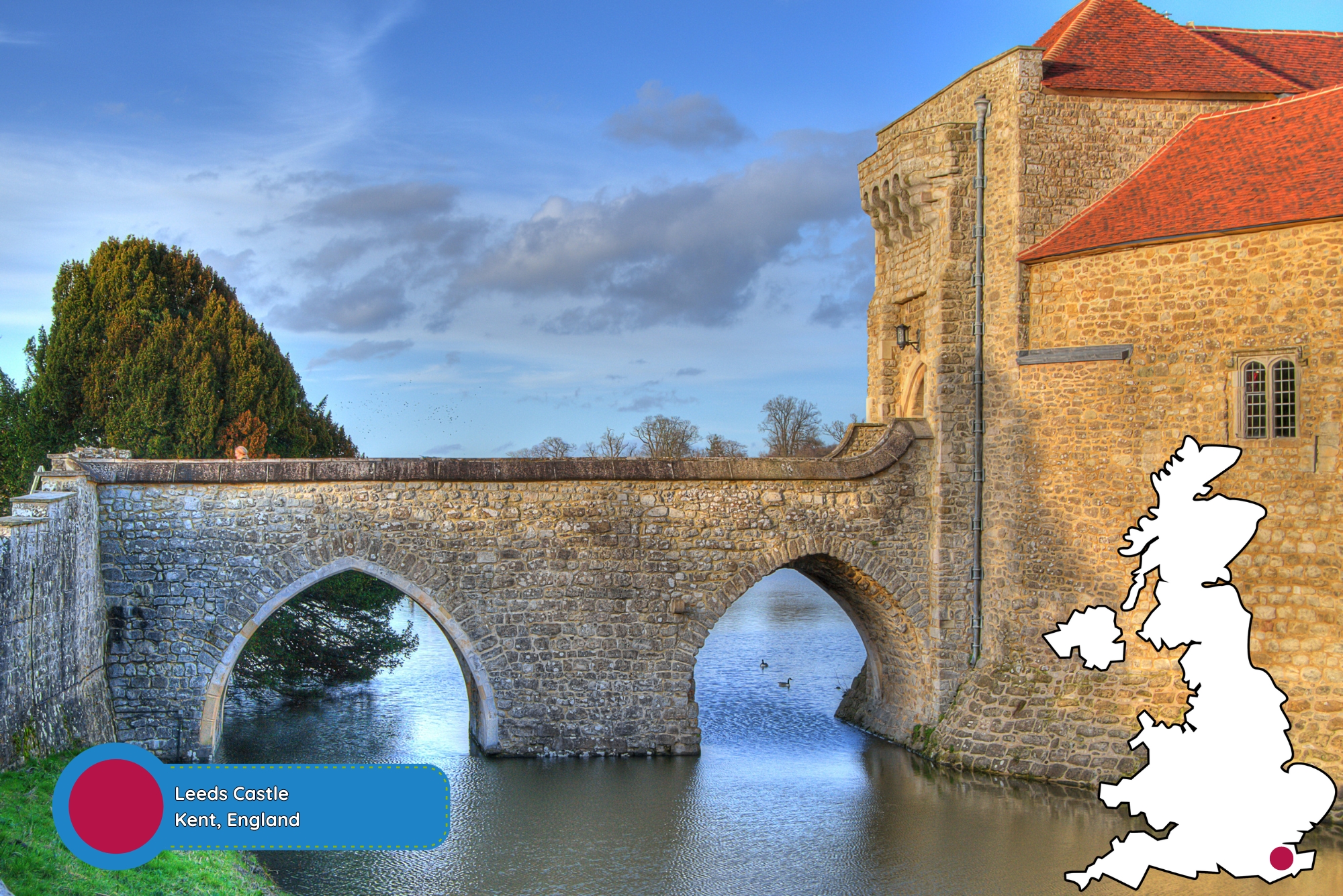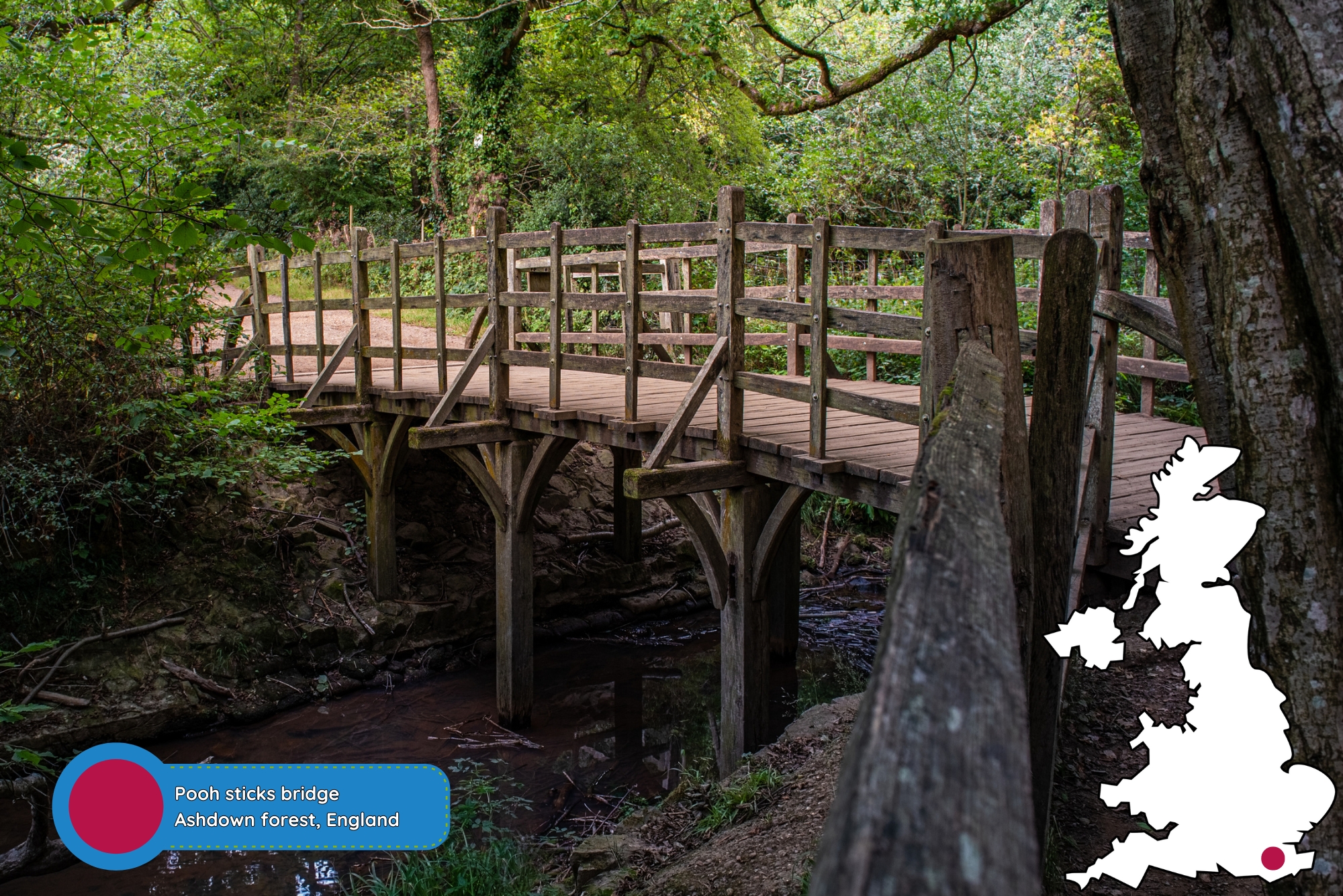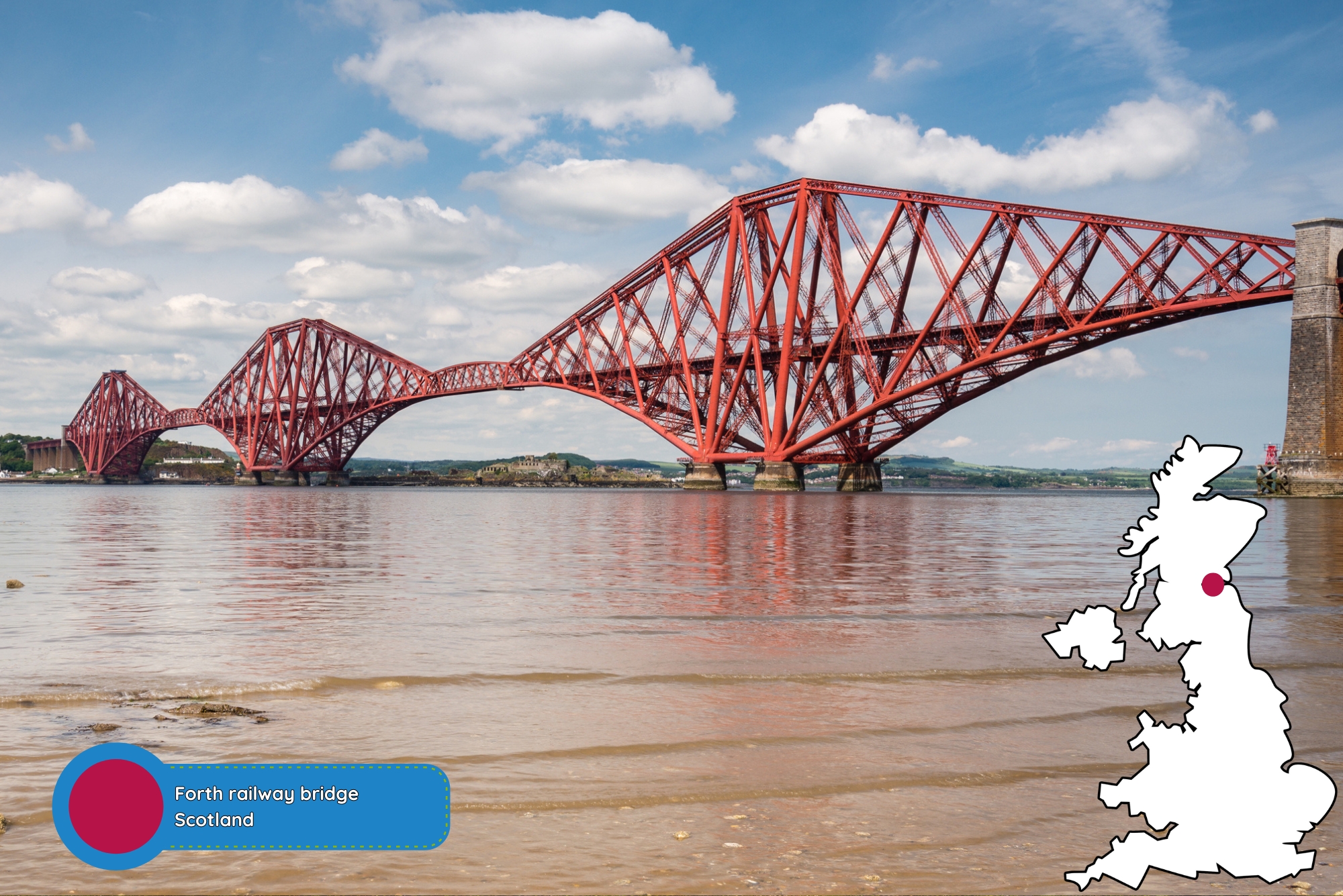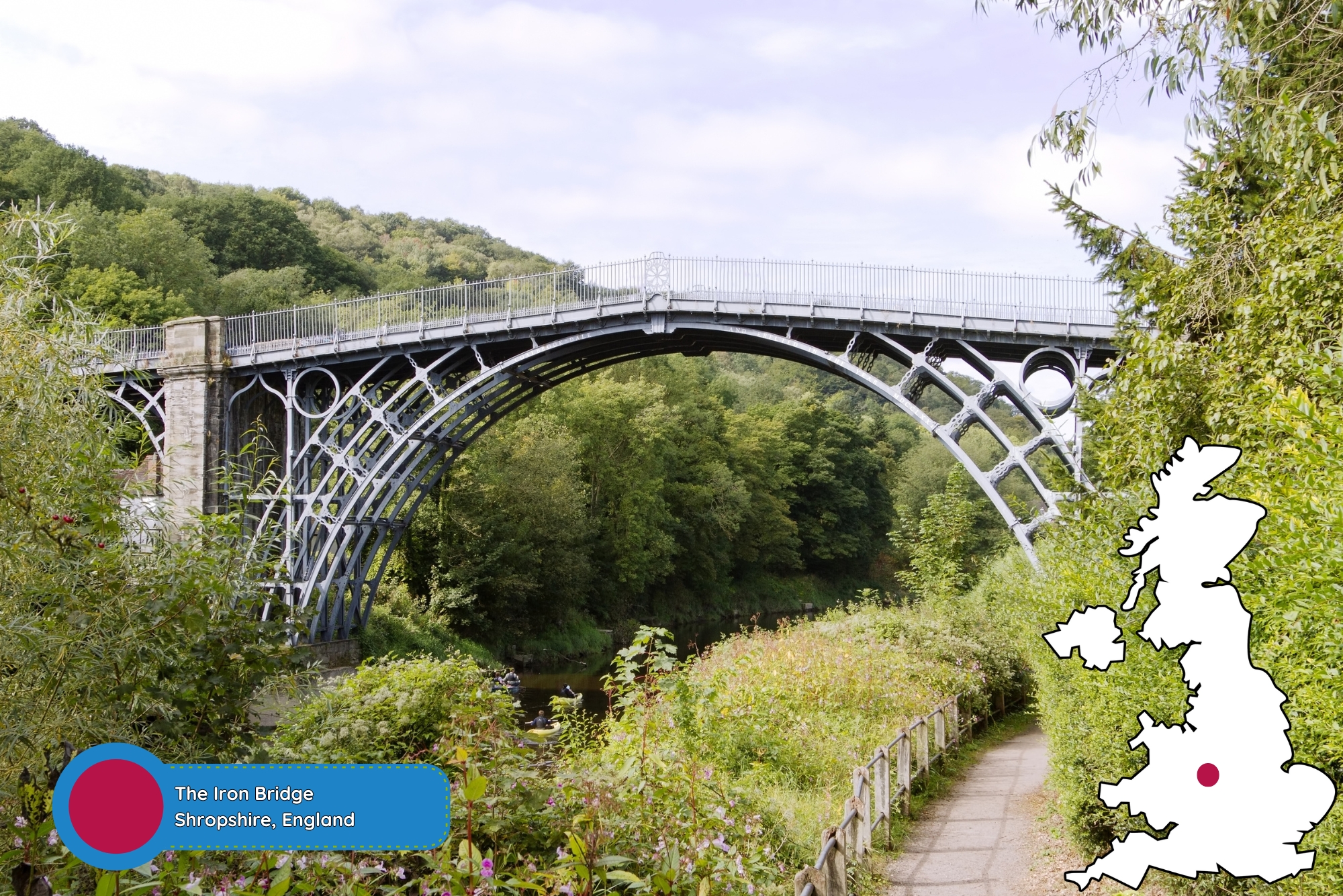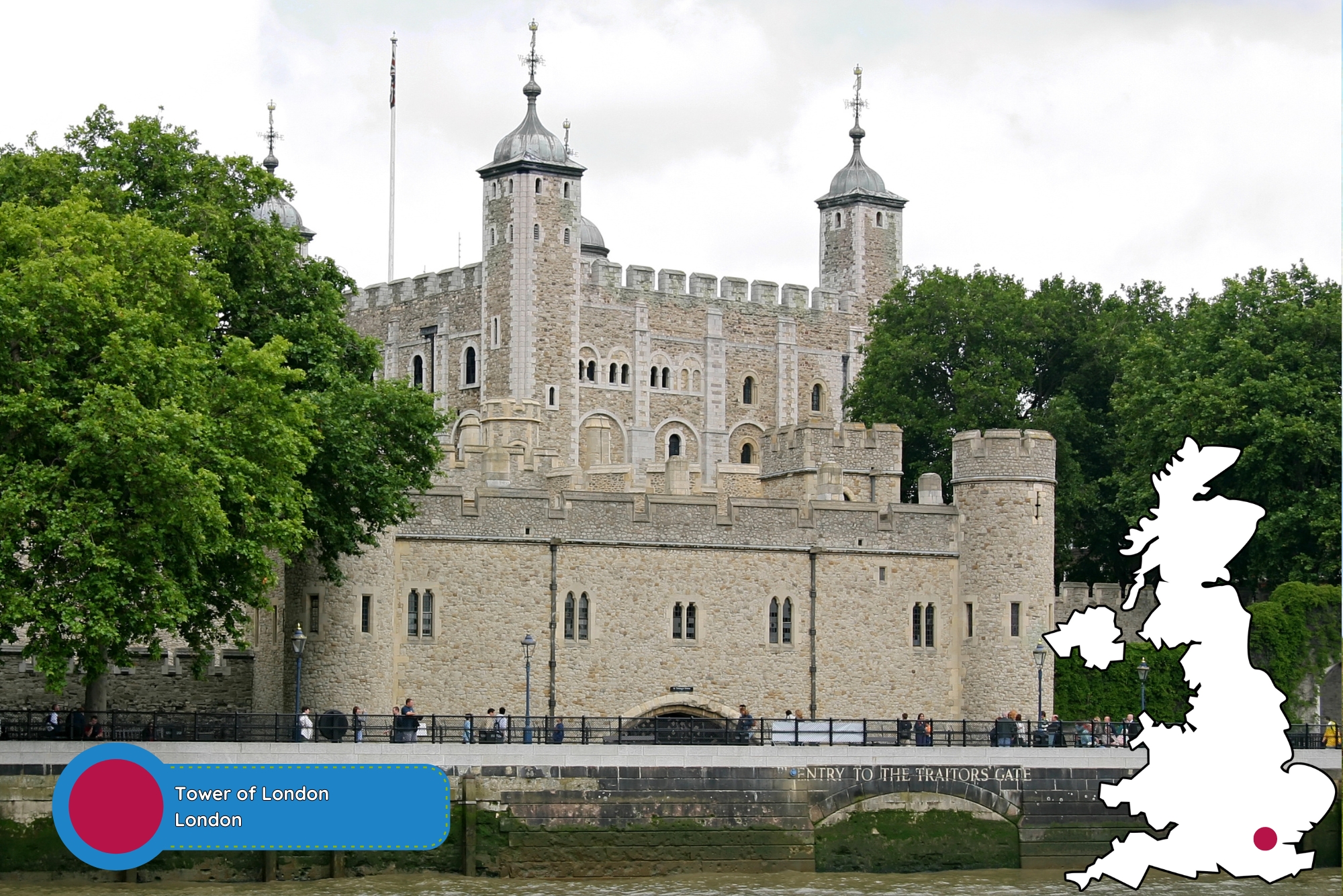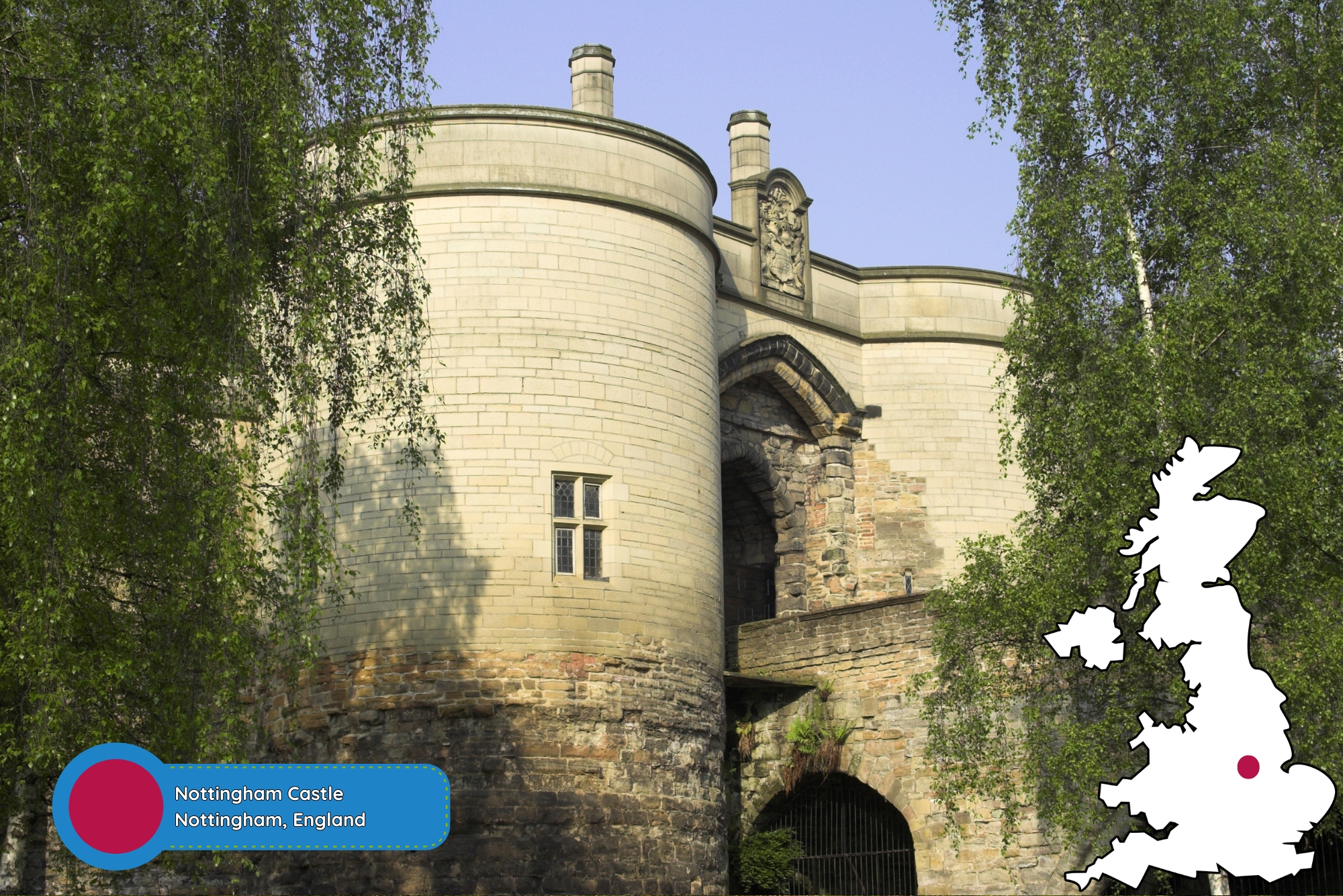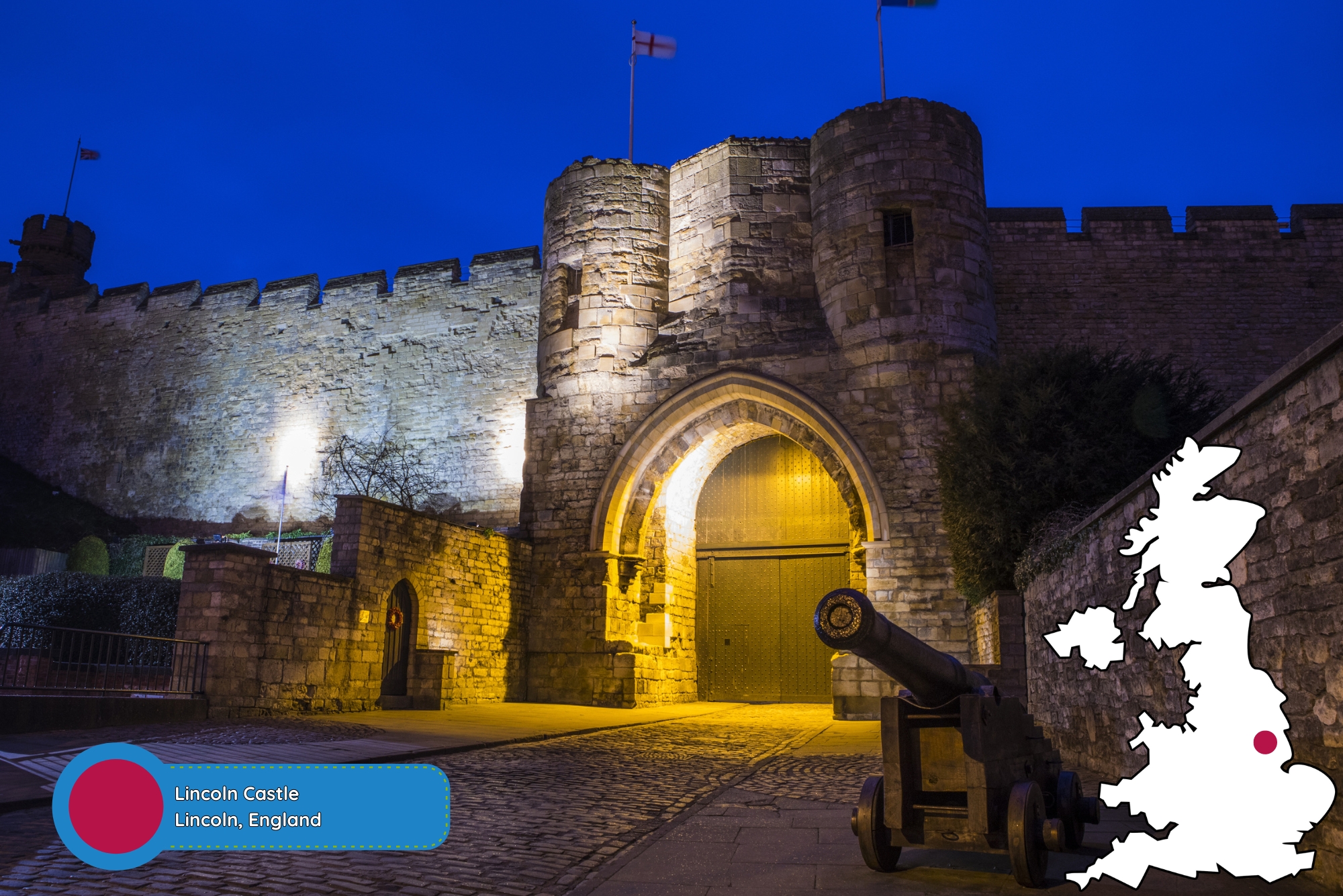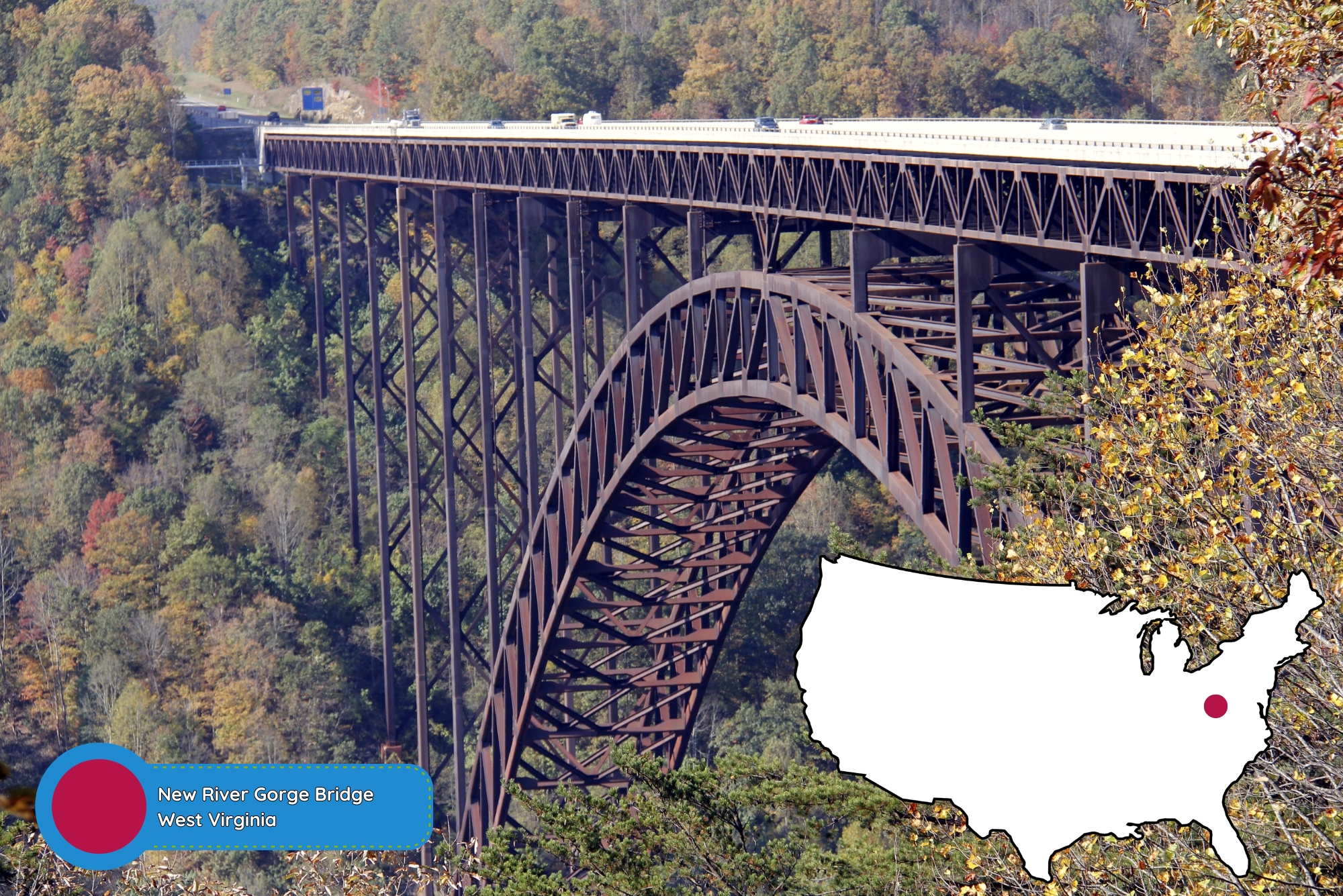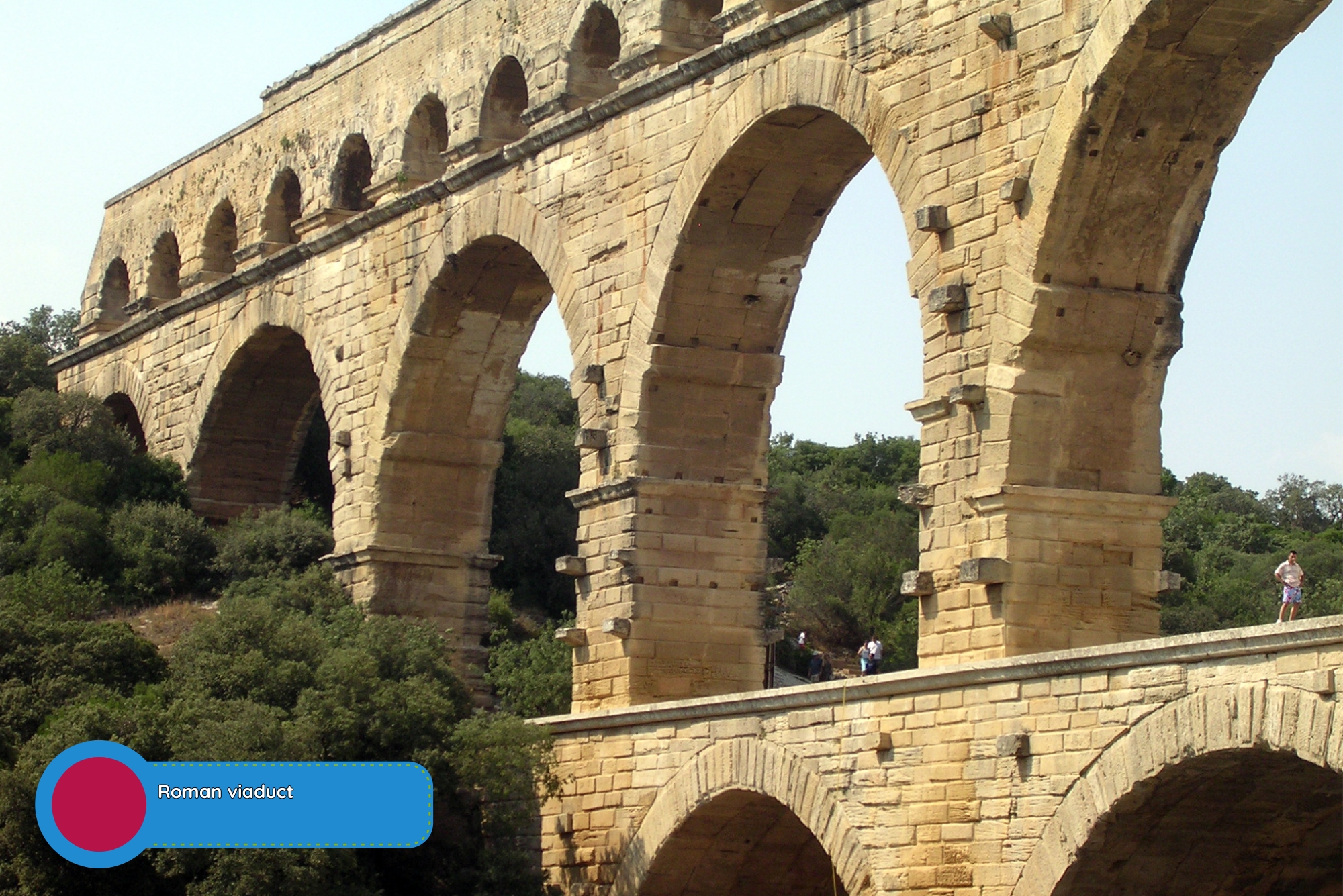KS1 – Castles and Bridges

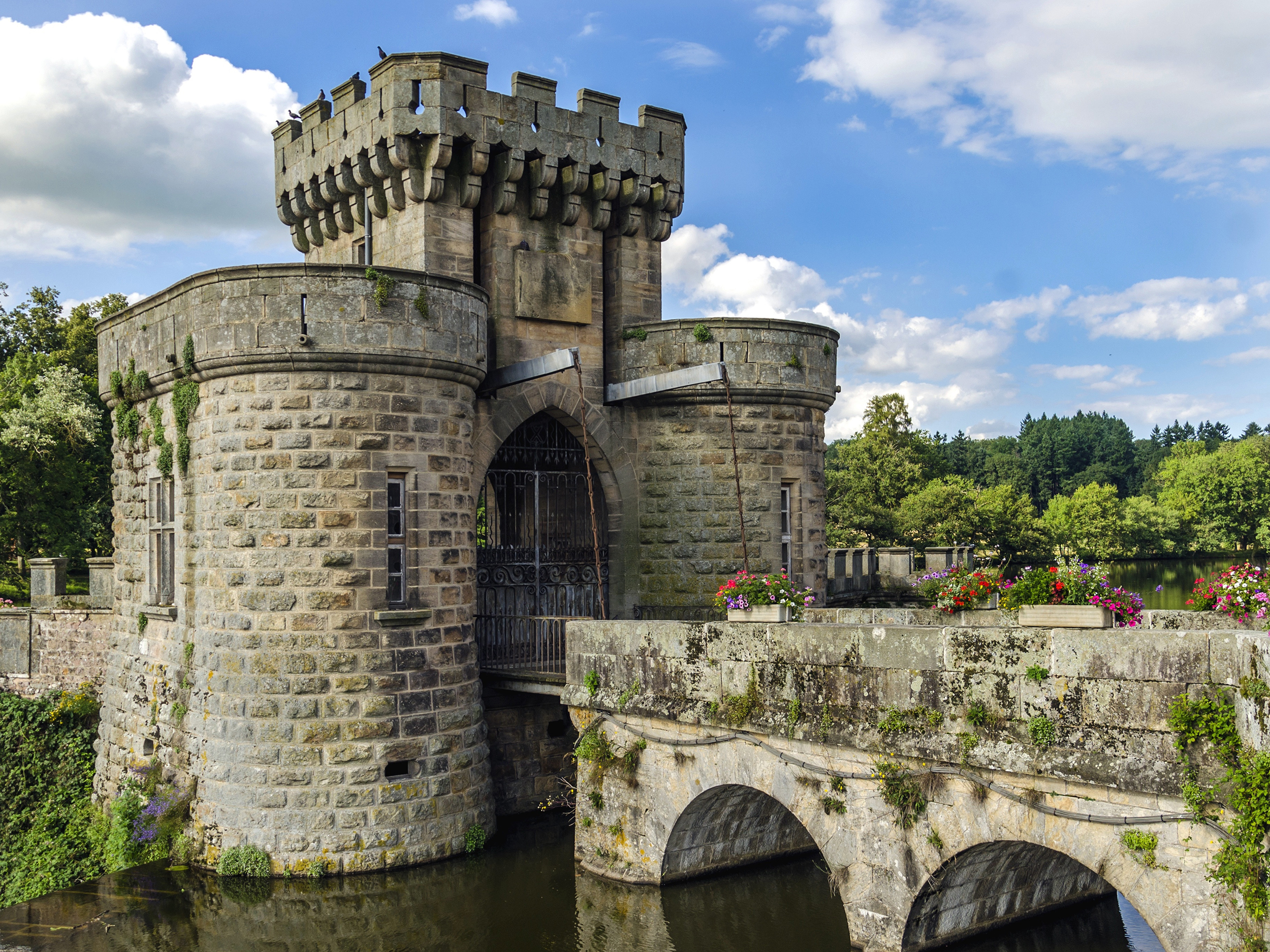
Sensory audio
This exciting topic will bring the world of castles and bridges to life! Children will embark on a journey through history, learning all about castles, bridges, and the fascinating stories behind them. This hands-on topic will cover a range of creative and educational activities, encouraging exploration of shapes, construction, history, and music.
Children will begin by exploring the height, length, and symmetry of castles and bridges, using 2D and 3D shapes to build their understanding of structure. They will practise counting, addition, and subtraction through fun activities centred around these medieval marvels.
In science, children will investigate the properties of materials and how forces like pushing and pulling affect drawbridges. They will also learn about weathering and how it impacts castles over time.
Art will play a big role in the topic as children sketch, draw, and paint shields, flags, banners, and stained glass windows. They’ll also construct towers, bridges, and make their own shields.
Medieval music will bring castles to life with fanfares, trumpet calls, and castle soundscapes. Children will listen to and create their own music inspired by the past.
Using digital maps, Google Earth, and Google Maps, children will explore famous castles, locate them on a map, and learn about the UK’s countries and capital cities. They will also discover bridges in religious stories and chapels found in castles.
Finally, children will dive into the history of castles and bridges, discovering why they were built, and enjoy active “Defend the Castle” games, medieval dance, and scavenger hunts.
ASSESSMENT
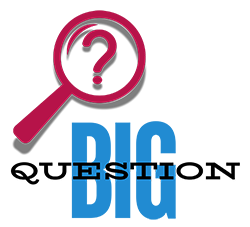
How have castles and bridges changed the way people live and travel?
VOCABULARY
ACTIVITIES
| ID | postID | Learning Objective | Activity | Resources | Assessment |
|---|
- There are no local learning opportunities or Magical, Memorable Moments for this unit yet.
Safeguarding
Ensure that all school risk assessment policies and procedures have been followed before taking children off-site.
| ID | postID | Activity | Instructions | Resources | safety |
|---|
| ID | PostID | Activity | Instructions | Resources | Safety |
|---|---|---|---|---|---|
| 1 | 116 | Build a Cardboard Castle | Create a castle using cardboard boxes, kitchen paper rolls, and other recyclable materials. | Cardboard boxes, kitchen paper rolls, glue, paint, scissors | Ensure scissors are child-safe. Supervise use of glue and paint. |
| 2 | 116 | Drawbridge Construction | Build a simple drawbridge using string, paper, and small boxes. | String, paper, small boxes, tape | Supervise use of string and tape to avoid entanglement. |
| 3 | 116 | Castle Story Time | Read a story about castles and knights, then draw scenes from the story. | Storybook about castles, drawing paper, crayons | Ensure crayons are non-toxic and appropriate for the child's age. |
| 4 | 116 | Lego Castle Building | Use Lego bricks to build a castle. Discuss different parts of a castle while building. | Lego bricks | Supervise to prevent choking hazards with small Lego pieces. |
| 5 | 116 | Bridge Building Challenge | Create bridges using various materials and test their strength with small weights. | Straws, tape, small toy cars, coins | Supervise the use of small weights to prevent injury. |
General safety tips:
- Always supervise children during home learning activities
- Ensure that materials are age-appropriate and non-toxic
- Create a safe, clutter-free workspace
- Wash hands after messy activities, especially when handling food
The activities not only support the learning objectives of the curriculum, but also provide an opportunity for quality bonding time between children and their parents, carers and families.
| ID | postID | Life skills component | Activity | Activity details | Resources | Skills |
|---|

|
Brilliant Bridges by Kay Barnham and illustrated by Laszlo Veres Buy this book on Amazon Buy this book on Amazon |

|
Castles by Maggie Freeman Buy this book on Amazon Buy this book on Amazon |

|
Jack and the Beanstalk by DK and illustrated by Giuseppe Di Lernia Buy this book on Amazon Buy this book on Amazon |

|
Jasper's Beanstalk by Nick Butterworth and Mick Inkpen Buy this book on Amazon Buy this book on Amazon |

|
Rapunzel by Stephanie Stansbie and illustrated by Loretta Schauer Buy this book on Amazon Buy this book on Amazon |

|
The Story of Robin Hood by Rob Lloyd Jones and illustrated by Alan Marks Buy this book on Amazon Buy this book on Amazon |

|
The Three Billy-Goats Gruff by Jacob Grimm and illustrated by Angela Hewitt Buy this book on Amazon Buy this book on Amazon |

|
The Tunnel by Anthony Browne Buy this book on Amazon Buy this book on Amazon |

|
Winnie the Pooh by A.A.Milne and illustrated by E.H.Shepard Buy this book on Amazon Buy this book on Amazon |

|
You Wouldn't Want To Be A Prisoner in the Tower of London! by Fiona Macdonald and illustrated by David Antram Buy this book on Amazon Buy this book on Amazon |

|
English Heritage Virtual tour of Goodrich Castle View this website in a new browser tab |
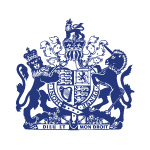
|
Windsor Castle A Royal home and fortress for over 900 years View this website in a new browser tab |

|
English Heritage Clifford's Tower View this website in a new browser tab |
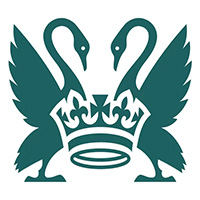
|
Leeds Castle Information and resources for teachers View this website in a new browser tab |
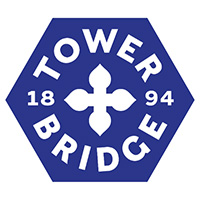
|
Tower Bridge Discover Tower Bridge's extraordinary history View this website in a new browser tab |
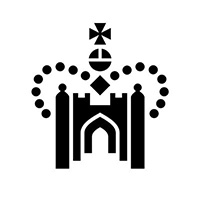
|
Historic Royal Palaces The Tower of London View this website in a new browser tab |

|
Royal Mail Special edition stamps and postcards - The Legend of Robin Hood View this website in a new browser tab |

|
Lincoln Castle A symbol of power and punishment through the ages and home to an original 1215 Magna Carta View this website in a new browser tab |
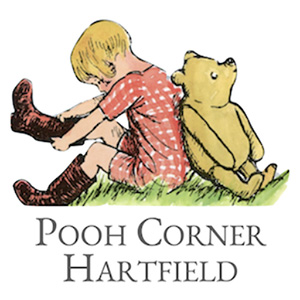
|
Pooh corner Situated on the edge of the Ashdown Forest, East Sussex in Hartfield. View this website in a new browser tab |
Click each location to view a Google Map in a new browser tab.

|
Clifton Suspension Bridge, Bristol |

|
Cliiford's Tower, York |

|
Edinburgh Castle |

|
Forth railway bridge, Scotland |

|
Glenfinnan Viaduct, Scotland |

|
Humber Bridge |

|
Leeds Castle, Kent |

|
Lincoln Castle |

|
Nottingham Castle |

|
Poohsticks Bridge, One Hundred Acre woods |

|
The Iron Bridge, Shropshire |

|
Tower Bridge and the Tower of London |

|
Windsor Castle |
Wooden toy castle  Buy this resource on Amazon Buy this resource on Amazon |
King dressing-up costume  Buy this resource on Amazon Buy this resource on Amazon |
Castle floor puzzle  Buy this resource on Amazon Buy this resource on Amazon |
Wooden Garden Bridge (1.5M)  Buy this resource on Amazon Buy this resource on Amazon |
Baker Ross Castle Wooden Pen Pot Kits - Pack of 2  Buy this resource on Amazon Buy this resource on Amazon |
Medieval Queen Outfit & Accessory  Buy this resource on Amazon Buy this resource on Amazon |
LEGO DUPLO Disney 3in1 Magical Castle  Buy this resource on Amazon Buy this resource on Amazon |
Tuff tray (100cm diameter)  Buy this resource on Amazon Buy this resource on Amazon |
Universal Tuff Tray Cover  Buy this resource on Amazon Buy this resource on Amazon |
Talking Products - Talking Tiles Voice Recorders, Communication Sound Buttons  Buy this resource on Amazon Buy this resource on Amazon |
| View general resource suggestions here |
Each of the 5 areas are interrelated and should be used when assessing pupils who are not engaged in subject-specific study. Each area can provide a focus on how well pupils are achieving a specific outcome or individual development target as set out in their EHC plans or high-needs funding agreements.
The 5 areas are not hierarchical, so there is no expectation that pupils need to demonstrate progress in all 5 areas. Instead, each of the areas represent what is necessary for pupils to fully engage in their development and reach their full potential. The areas also provide the scaffolding to enable pupils to become independent in developing a new skill or concept.
.
| ID | Step | Category | Outcome | EM Area | Age |
|---|---|---|---|---|---|
| 1 | 1 | Attention | Demonstrate a reflex response to their own sounds | Anticipation | 0-3 months |
| 2 | 1 | Attention | Demonstrate reflex responses when not engaged with others | Exploration | 0-3 months |
| 3 | 1 | Attention | Give momentary attention to familiar food containers in front of them | Exploration | 0-3 months |
| 4 | 1 | Attention | Give momentary attention to pictures put in front of them | Exploration | 0-3 months |
| 5 | 1 | Attention | Glance at light briefly when the source enters their field of vision | Exploration | 0-3 months |
| 6 | 1 | Attention | Glance at objects within 50 centimetres when the objects are moved closer | Exploration | 0-3 months |
| 7 | 1 | Attention | Open eyes for brief periods when encountering stimulating events | Anticipation | 0-3 months |
| 8 | 1 | Attention | React to a range of sounds that are close by | Anticipation | 0-3 months |
| 9 | 1 | Attention | React to light with minor physiological changes when environmental lighting changes dramatically | Anticipation | 0-3 months |
| 10 | 1 | Attention | React to movement with minor physiological changes when objects or people move suddenly | Anticipation | 0-3 months |
| 11 | 1 | Attention | React to noise with minor physiological changes when the environmental volume changes suddenly | Anticipation | 0-3 months |
| 12 | 1 | Attention | React to physical contact with minor physiological changes when hands are touched lightly | Anticipation | 0-3 months |
| 13 | 1 | Attention | React to physical contact with minor physiological changes when their hands are touched | Anticipation | 0-3 months |
| 14 | 1 | Attention | React to textures with minor physiological changes when feeling rough or smooth surfaces | Exploration | 0-3 months |
| 15 | 1 | Attention | Startle to a sudden change in light | Anticipation | 0-3 months |
| 16 | 1 | Attention | Startle to sudden loud noises | Anticipation | 0-3 months |
| 17 | 1 | Attention | Startle to sudden movement | Anticipation | 0-3 months |
| 18 | 1 | Attention | React to pain and other unpleasant stimuli | Anticipation | 0-3 months |
| 19 | 1 | Attention | Vocalise in response to pain or other unpleasant stimuli | Anticipation | 0-3 months |
| 20 | 2 | Attention | Attend briefly to items with their mouth when provided with suitable objects | Exploration | 0-3 months |
| 21 | 2 | Attention | Attend briefly to their hands and fingers when not engaged with a member of staff | Exploration | 0-3 months |
| 22 | 2 | Attention | Attend briefly to their immediate environment intermittently with vision or grasp when not engaged with a member of staff | Exploration | 0-3 months |
| 23 | 2 | Attention | Engage in an activity for three seconds with a familiar person | Persistence | 0-3 months |
| 24 | 2 | Attention | Engage in an activity for five seconds with a familiar person | Persistence | 0-3 months |
| 25 | 2 | Attention | Focus attention on moving faces intermittently when within their visual range | Exploration | 0-3 months |
| 26 | 2 | Attention | Focus attention on moving objects intermittently when within their visual range | Exploration | 0-3 months |
| 27 | 2 | Attention | Focus attention on moving sounds intermittently when within auditory range | Exploration | 0-3 months |
| 28 | 2 | Attention | Follow an object with their eyes briefly when it moves past midline | Exploration | 0-3 months |
| 29 | 2 | Attention | Maintain attention on certain objects for five seconds when alert and ready | Persistence | 0-3 months |
| 30 | 2 | Attention | Maintain attention on certain voices for five seconds when alert and ready | Persistence | 0-3 months |
| 31 | 2 | Attention | Maintain attention on certain events for five seconds when alert and ready | Persistence | 0-3 months |
| 32 | 2 | Attention | Put hands on spoon or cup whilst being fed (but doesn't hold independently) | Exploration | 0-3 months |
| 33 | 2 | Attention | React to changes with facial gestures intermittently | Anticipation | 0-3 months |
| 34 | 2 | Attention | Watch the movement of their own limbs briefly | Exploration | 0-3 months |
| 35 | 2 | Attention | Watch their own hand movements briefly | Exploration | 0-3 months |
| 36 | 2 | Attention | Focus on a face which is within close proximity | Exploration | 0-3 months |
| 37 | 2 | Attention | Focus on a static object which is within close proximity | Exploration | 0-3 months |
| 38 | 2 | Attention | Watch the faces of other people eating briefly | Exploration | 0-3 months |
| 39 | 3 | Attention | Anticipate loud noise by startling less when experiencing sudden noises, e.g. doorbell, door slam | Anticipation | 3-6 months |
| 40 | 3 | Attention | Attempt to grab objects of interest using a raking motion | Exploration | 3-6 months |
| 41 | 3 | Attention | Change their facial expressions when faces disappear from view, e.g. peek-a-boo | Anticipation | 3-6 months |
| 42 | 3 | Attention | Demonstrate a brief interest in noises in their immediate environment when encouraged by a member of staff | Exploration | 3-6 months |
| 43 | 3 | Attention | Demonstrate a brief interest in sights in their immediate environment when encouraged by a member of staff | Exploration | 3-6 months |
| 44 | 3 | Attention | Direct their body movements towards a member of staff when engaging in an activity | Initiation | 3-6 months |
| 45 | 3 | Attention | Engage in co-active exploration proactively when working with a member of staff | Persistence | 3-6 months |
| 46 | 3 | Attention | Imitate environmental sounds in their own manner | Initiation | 3-6 months |
| 47 | 3 | Attention | Imitate sounds in their own manner when interacting with a familiar member of staff or more able peer | Initiation | 3-6 months |
| 48 | 3 | Attention | Look at a person/activity, maintaining eye contact when engaged by a member of staff | Persistence | 3-6 months |
| 49 | 3 | Attention | Change facial expressions when objects disappear from view, e.g. falls off a table | Anticipation | 3-6 months |
| 50 | 3 | Attention | React to an instruction positively or negatively when a member of staff initiates interaction | Anticipation | 3-6 months |
| 51 | 3 | Attention | Search for partially hidden objects with their eyes or hands when playing alone | Persistence | 3-6 months |
| 52 | 3 | Attention | Turn their head to observe the environment when initiating play | Initiation | 3-6 months |
| 53 | 3 | Attention | React consistently to stimuli when interacting with familiar activities, e.g. babbling starts/stops when a musical toy plays | Anticipation | 3-6 months |
| 54 | 3 | Attention | Explore a desired object with their hands for up to 10 seconds when provided with a variety of objects | Exploration | 3-6 months |
| 55 | 3 | Attention | Explore a desired object with their mouth for up to 10 seconds when provided with a variety of objects | Exploration | 3-6 months |
| 56 | 3 | Attention | Notice peers briefly when alongside them during play situations | Exploration | 3-6 months |
| 57 | 3 | Attention | Hold their head steady when looking at a familiar person | Persistence | 3-6 months |
| 58 | 3 | Attention | Hold their head steady when looking at a favoured object | Persistence | 3-6 months |
| 59 | 3 | Attention | Hold their head steady when looking at a new object | Persistence | 3-6 months |
| 60 | 3 | Attention | Hold their head steady when looking at a new person | Persistence | 3-6 months |
| 61 | 3 | Attention | Hold their head steady when looking at an interesting event | Persistence | 3-6 months |
| 62 | 3 | Attention | Hold their head steady when looking at a different/new event | Persistence | 3-6 months |
| 63 | 4 | Attention | Follow a simple one- or two-key word instruction when accompanied by gestures and context | Realisation | 6-12 months |
| 64 | 4 | Attention | Listen to a member of staff briefly when they are spoken to | Exploration | 6-12 months |
| 65 | 4 | Attention | Anticipate a routine demonstrating an expectation of familiar actions when given a visual cue | Anticipation | 6-12 months |
| 66 | 4 | Attention | Anticipate a routine demonstrating an expectation of familiar actions when given an auditory cue | Anticipation | 6-12 months |
| 67 | 4 | Attention | Attend to changes pointed out by a member of staff in their environment aurally when transitioning from subject to subject | Realisation | 6-12 months |
| 68 | 4 | Attention | Concentrate on a task for three minutes when working independently | Persistence | 6-12 months |
| 69 | 4 | Attention | Concentrate on a task for five minutes when working independently | Persistence | 6-12 months |
| 70 | 4 | Attention | Explore an activity for three minutes when working coactively | Exploration | 6-12 months |
| 71 | 4 | Attention | Explore an activity for five minutes when working coactively | Exploration | 6-12 months |
| 72 | 4 | Attention | Explore an object for three minutes when working coactively | Exploration | 6-12 months |
| 73 | 4 | Attention | Explore an object for five minutes when working coactively | Exploration | 6-12 months |
| 74 | 4 | Attention | Look at events by pushing up on their arms/lifting head when lying on their stomach | Exploration | 6-12 months |
| 75 | 4 | Attention | Look at people by pushing up on their arms/lifting head when lying on their stomach | Exploration | 6-12 months |
| 76 | 4 | Attention | Maintain interest in pictures for a minute while the content is named | Persistence | 6-12 months |
| 77 | 4 | Attention | Observe events with interest when they are the result of their own actions | Exploration | 6-12 months |
| 78 | 4 | Attention | Pick up and look at a new/unfamiliar object | Exploration | 6-12 months |
| 79 | 4 | Attention | Play with objects happily | Exploration | 6-12 months |
| 80 | 4 | Attention | Co-operate with a member of staff either passively or actively whilst eating | Persistence | 6-12 months |
| 81 | 4 | Attention | Observe others with interest when not engaged in an activity | Exploration | 6-12 months |
| 82 | 4 | Attention | Point at people with their fingers/eyes when interested in them | Initiation | 6-12 months |
| 83 | 4 | Attention | Recognise their reflected self by making intentional movement and watching reaction when shown a mirror | Realisation | 6-12 months |
| 84 | 4 | Attention | Search for partially hidden objects with their eyes or hands when playing with a member of staff | Persistence | 6-12 months |
| 85 | 4 | Attention | Move towards a new/unfamiliar object | Exploration | 6-12 months |
| 86 | 4 | Attention | Show an interest in books when ‘reading’ with a member of staff | Exploration | 6-12 months |
| 87 | 4 | Attention | Watch members of staff for short periods of time whilst not engaged in a task | Exploration | 6-12 months |
| 88 | 4 | Attention | Watch peers play with interest whilst not engaged with a member of staff | Exploration | 6-12 months |
| 89 | 4 | Attention | Watch the activities of members of staff with interest when the interactions happen nearby | Exploration | 6-12 months |
| 90 | 4 | Attention | Vocalise to a member of staff to attract attention when not engaged in a task | Initiation | 6-12 months |
| 91 | 4 | Attention | Vocalise to a member of staff to keep attention when engaged in conversation | Initiation | 6-12 months |
| 92 | 5 | Attention | Join in rhymes or jingles with babble and a few recognisable words, signs, or symbols | Initiation | 12-21 months |
| 93 | 5 | Attention | Join in songs with babble and a few recognisable words, signs, or symbols | Initiation | 12-21 months |
| 94 | 5 | Attention | Join in with repetition of a story or song independently | Persistence | 12-21 months |
| 95 | 5 | Attention | Participate in singing activities | Initiation | 12-21 months |
| 96 | 5 | Attention | Listen as a member of staff talks about a book | Exploration | 12-21 months |
| 97 | 5 | Attention | Listen to, and can engage with, music they have not heard before | Exploration | 12-21 months |
| 98 | 5 | Attention | Follow simple commands with appropriate responses, e.g. rolls the ball when requested to | Realisation | 12-21 months |
| 99 | 5 | Attention | Repeat a member of staff's last word | Persistence | 12-21 months |
| 100 | 5 | Attention | Respond to one-step commands appropriately when asked clearly by a member of staff, e.g. “Get your shoes” | Realisation | 12-21 months |
| 101 | 5 | Attention | Complete a simple task when requested, e.g. puts their cup in the sink when asked | Realisation | 12-21 months |
| 102 | 5 | Attention | Demonstrate anticipation when specific equipment is distributed | Anticipation | 12-21 months |
| 103 | 5 | Attention | Demonstrate anticipation when specific sounds are heard | Anticipation | 12-21 months |
| 104 | 5 | Attention | Play independently for four minutes | Persistence | 12-21 months |
| 105 | 5 | Attention | Play independently for six minutes | Persistence | 12-21 months |
| 106 | 5 | Attention | Play independently for ten minutes | Persistence | 12-21 months |
| 107 | 5 | Attention | Respond when informed it is lunchtime | Realisation | 12-21 months |
| 108 | 5 | Attention | Respond to voices with background noise present | Realisation | 12-21 months |
| 109 | 5 | Attention | Take part in a simple one-to-one listening game | Persistence | 12-21 months |
| 110 | 5 | Attention | Demonstrate intense curiosity | Exploration | 12-21 months |
| 111 | 5 | Attention | Pass an object when asked | Realisation | 12-21 months |
| 112 | 5 | Attention | Become involved in their own activity | Exploration | 12-21 months |
| 113 | 5 | Attention | Stay involved in an independent activity which interests them | Persistence | 12-21 months |
| 114 | 5 | Attention | Pull faces with peers | Initiation | 12-21 months |
| 115 | 5 | Attention | Recognise self in mirror | Realisation | 12-21 months |
| 116 | 5 | Attention | Scribble on paper and attend to the marks they have made when prompted by a member of staff | Exploration | 12-21 months |
| 117 | 5 | Attention | Stop an activity to handle/view a new object | Exploration | 12-21 months |
| 118 | 5 | Attention | Go to a requested place, e.g. book corner | Realisation | 12-21 months |
| 119 | 5 | Attention | Care for the classroom pets or plants | Persistence | 12-21 months |
| 120 | 5 | Attention | Orientate their head or eyes towards an object when a member of staff points at it | Exploration | 12-21 months |
| 121 | 5 | Attention | Exercise some care when warned something is dangerous | Realisation | 12-21 months |
| 122 | 5 | Attention | Defecate generally on toilet if placed there at the appropriate time | Realisation | 12-21 months |
| 123 | 6 | Attention | Concentrate during independent exploration for ten minutes | Persistence | 21-36 months |
| 124 | 6 | Attention | Communicate about the effects of different tools on dough | Realisation | 21-36 months |
| 125 | 6 | Attention | Communicate the similarities between a new object and a familiar one | Realisation | 21-36 months |
| 126 | 6 | Attention | Compare objects when investigating which interests them more | Exploration | 21-36 months |
| 127 | 6 | Attention | Compare the weight of two objects with assistance | Realisation | 21-36 months |
| 128 | 6 | Attention | Compare their food with another person's, commenting on the differences | Realisation | 21-36 months |
| 129 | 6 | Attention | Concentrate without support for up to ten minutes | Persistence | 21-36 months |
| 130 | 6 | Attention | Copy a simple three beat rhythm | Realisation | 21-36 months |
| 131 | 6 | Attention | Experiment with moving to music in different ways | Exploration | 21-36 months |
| 132 | 6 | Attention | Experiment with the use of tools with dough | Exploration | 21-36 months |
| 133 | 6 | Attention | Explore an activity for ten minutes independently, communicating what they have found | Exploration | 21-36 months |
| 134 | 6 | Attention | Explore an activity/object for up to ten minutes | Exploration | 21-36 months |
| 135 | 6 | Attention | Express what they are doing and give a reason, using words, signs or symbols | Realisation | 21-36 months |
| 136 | 6 | Attention | Feel objects that may be hot with care | Realisation | 21-36 months |
| 137 | 6 | Attention | Find materials with a specific property, e.g. feel different objects in the garden to find a collection of rough items | Exploration | 21-36 months |
| 138 | 6 | Attention | Imitate a range of sounds which are loud, quiet, quick or slow | Initiation | 21-36 months |
| 139 | 6 | Attention | Join in a small group rhyme or story activity | Initiation | 21-36 months |
| 140 | 6 | Attention | Join in adult-led group activity | Persistence | 21-36 months |
| 141 | 6 | Attention | Join in with familiar poems and songs | Initiation | 21-36 months |
| 142 | 6 | Attention | Listen as part of a group for short periods | Exploration | 21-36 months |
| 143 | 6 | Attention | Listen for the answers to questions | Realisation | 21-36 months |
| 144 | 6 | Attention | Listen for, and try to identify, sounds in the setting | Exploration | 21-36 months |
| 145 | 6 | Attention | Respond to prompting to finish food or continue eating | Persistence | 21-36 months |
| 146 | 6 | Attention | Explore sounds they can make with instruments | Exploration | 21-36 months |
| 147 | 6 | Attention | Relate an event to their own experience | Realisation | 21-36 months |
| 148 | 6 | Attention | Place their coat on a hook | Realisation | 21-36 months |
| 149 | 6 | Attention | Pour water from one container to another with little spillage | Realisation | 21-36 months |
| 150 | 6 | Attention | Say rhymes with recognisable words when playing by themselves | Initiation | 21-36 months |
| 151 | 6 | Attention | Show enjoyment in saying a new word | Initiation | 21-36 months |
| 152 | 6 | Attention | Look at others to see their response, e.g. to a noise | Exploration | 21-36 months |
| 153 | 6 | Attention | Look at the object, person, or event to which a member of staff is referring | Exploration | 21-36 months |
| 154 | 6 | Attention | Look at others' work | Exploration | 21-36 months |
| 155 | 6 | Attention | Look for missing person | Exploration | 21-36 months |
| 156 | 6 | Attention | Organise themselves when going to the toilet, but needs adult presence | Realisation | 21-36 months |
| 157 | 6 | Attention | Sit still for short periods of time | Persistence | 21-36 months |
| 158 | 6 | Attention | Demonstrate curiosity in the outside world | Exploration | 21-36 months |
| 159 | 6 | Attention | Eat and swallow only edible substances | Realisation | 21-36 months |
| 160 | 6 | Attention | Demonstrate curiosity in new foods | Exploration | 21-36 months |
| 161 | 6 | Attention | Respond to member of staff's reaction to their own action | Realisation | 21-36 months |
| 162 | 6 | Attention | Demonstrate an interest in another's play and will join in | Initiation | 21-36 months |
| 163 | 6 | Attention | Match a picture to an object | Realisation | 21-36 months |
| 164 | 6 | Attention | Match pairs of objects with assistance | Realisation | 21-36 months |
| 165 | 6 | Attention | Match pictures to objects with assistance | Realisation | 21-36 months |
| 166 | 6 | Attention | Match pictures to pictures with assistance | Realisation | 21-36 months |
| 167 | 6 | Attention | Mix different paint colours and observe the change | Exploration | 21-36 months |
| 168 | 6 | Attention | Put rubbish in the bin | Realisation | 21-36 months |
| 169 | 6 | Attention | Share an activity with another person for five minutes, e.g. share a book | Persistence | 21-36 months |
| 170 | 6 | Attention | Share out things to other people in the group | Realisation | 21-36 months |
| 171 | 6 | Attention | Sit appropriately in public spaces | Realisation | 21-36 months |
| 172 | 6 | Attention | Sit on a chair appropriately | Realisation | 21-36 months |
| 173 | 6 | Attention | Take an appropriate amount of toilet paper | Realisation | 21-36 months |
| 174 | 6 | Attention | Express an awareness of other people's belongings | Realisation | 21-36 months |
| 175 | 6 | Attention | Match 2D shapes | Realisation | 21-36 months |
| 176 | 6 | Attention | Match objects to pictures | Realisation | 21-36 months |
| 177 | 6 | Attention | Match colours | Realisation | 21-36 months |
| 178 | 1 | Communication | Accept a change in their position | Realisation | 0-3 months |
| 179 | 1 | Communication | Accept being supported in a sitting position | Realisation | 0-3 months |
| 180 | 1 | Communication | Accept being washed | Realisation | 0-3 months |
| 181 | 1 | Communication | Accept laying on either side | Realisation | 0-3 months |
| 182 | 1 | Communication | Demonstrate distress when hungry | Anticipation | 0-3 months |
| 183 | 2 | Communication | Indicate a preference by reacting positively to the start of favourite music | Anticipation | 0-3 months |
| 184 | 2 | Communication | Like an object consistently when involved in familiar routines | Anticipation | 0-3 months |
| 185 | 2 | Communication | Dislike an object consistently when involved in familiar routines | Anticipation | 0-3 months |
| 186 | 2 | Communication | Like an event consistently when involved in familiar routines | Anticipation | 0-3 months |
| 187 | 2 | Communication | Acknowledge pleasure by intermittent responsive smiling when provided with enjoyable smells | Anticipation | 0-3 months |
| 188 | 2 | Communication | Dislike an event consistently when involved in familiar routines | Anticipation | 0-3 months |
| 189 | 3 | Communication | Express eagerness vocally or physically when presented with a familiar activity | Anticipation | 3-6 months |
| 190 | 3 | Communication | Express eagerness vocally or physically when presented with a familiar object | Anticipation | 3-6 months |
| 191 | 3 | Communication | Express eagerness vocally or physically when presented with a familiar person | Anticipation | 3-6 months |
| 192 | 3 | Communication | Express eagerness vocally when presented with a new object | Anticipation | 3-6 months |
| 193 | 3 | Communication | Express eagerness vocally when presented with a new activity | Anticipation | 3-6 months |
| 194 | 3 | Communication | Express eagerness vocally when presented with familiar food/drink | Anticipation | 3-6 months |
| 195 | 3 | Communication | Protest through facial expression or vocalisation when a desired activity stops, or an object is removed by a member of staff | Persistence | 3-6 months |
| 196 | 3 | Communication | Indicate a preference for specific textures by moving their hand from one to another when working with a member of staff | Realisation | 3-6 months |
| 197 | 3 | Communication | Initiate vocal play by chuckling when not engaged with a member of staff | Initiation | 3-6 months |
| 198 | 3 | Communication | Initiate vocal play by cooing when not engaged with a member of staff | Initiation | 3-6 months |
| 199 | 3 | Communication | Initiate vocal play by gurgling when not engaged with a member of staff | Initiation | 3-6 months |
| 200 | 3 | Communication | Make sounds to a member of staff when engaging in an activity | Initiation | 3-6 months |
| 201 | 3 | Communication | Reinforce choice/understanding with response, e.g. smiling | Realisation | 3-6 months |
| 202 | 3 | Communication | Show preferences by pointing/gesturing when provided with both a favoured and a disliked option | Realisation | 3-6 months |
| 203 | 3 | Communication | Vocalise to a member of staff in different ways when experiencing different needs | Initiation | 3-6 months |
| 204 | 4 | Communication | Communicate consistent preferences with emotional responses when choices are provided | Realisation | 6-12 months |
| 205 | 4 | Communication | Request a favourite activity through their chosen form of communication when self-selecting tasks | Realisation | 6-12 months |
| 206 | 4 | Communication | Request physical contact with gestures or vocalisations when playing with peers | Initiation | 6-12 months |
| 207 | 4 | Communication | Communicate with a member of staff by using an individual action or gesture when they want something | Realisation | 6-12 months |
| 208 | 4 | Communication | Communicate with a member of staff by using consistent vocal noises when they want something | Realisation | 6-12 months |
| 209 | 4 | Communication | Engage in new activities willingly when offered them by a familiar member of staff | Exploration | 6-12 months |
| 210 | 4 | Communication | Indicate a preference when provided with two symbols of equally liked items | Realisation | 6-12 months |
| 211 | 4 | Communication | Indicate a preference when provided with two pictures of equally liked items | Realisation | 6-12 months |
| 212 | 4 | Communication | Indicate a preference when provided with two equally liked items | Realisation | 6-12 months |
| 213 | 4 | Communication | Initiate communication with a member of staff by going to a specific place, e.g. waiting by the cupboard for it to be opened | Initiation | 6-12 months |
| 214 | 4 | Communication | Initiate communication with a member of staff by pulling them to a location | Initiation | 6-12 months |
| 215 | 4 | Communication | Initiate social games by taking a proactive role when engaging with a member of staff, e.g. hides their face and reveals it to start peek-a-boo | Initiation | 6-12 months |
| 216 | 4 | Communication | Make an intentional selection by eye-pointing/switch-pressing/etc. when provided with a choice of two | Realisation | 6-12 months |
| 217 | 4 | Communication | Make requests for desired objects with gestures or vocalisations | Initiation | 6-12 months |
| 218 | 4 | Communication | Protest vocally to a disliked or unknown foodstuff | Persistence | 6-12 months |
| 219 | 4 | Communication | React to the question “More?” with a heightened expressive response when offered continuation of an activity | Anticipation | 6-12 months |
| 220 | 4 | Communication | Reject interaction/an object by turning their head or pushing away when provided with a disliked activity | Persistence | 6-12 months |
| 221 | 4 | Communication | Request 'more' of an action or object in their chosen form of communication | Initiation | 6-12 months |
| 222 | 4 | Communication | Communicate with a member of staff by using an individual action or gesture when they are hungry or thirsty | Realisation | 6-12 months |
| 223 | 4 | Communication | Gesture to a member of staff to attract attention when not engaged in a task | Initiation | 6-12 months |
| 224 | 4 | Communication | Protest the conclusion of an activity after working with a member of staff | Persistence | 6-12 months |
| 225 | 4 | Communication | Indicate they wish to handle a new/unfamiliar object | Realisation | 6-12 months |
| 226 | 4 | Communication | Attract attention from a member of staff when they want something | Initiation | 6-12 months |
| 227 | 4 | Communication | Refuse an object, activity or foodstuff when given to them by a member of staff, e.g. verbally or physically | Persistence | 6-12 months |
| 228 | 5 | Communication | Combine sounds and gestures to indicate a need | Realisation | 12-21 months |
| 229 | 5 | Communication | Respond to choices with actions or gestures when given options | Realisation | 12-21 months |
| 230 | 5 | Communication | Communicate likes or dislikes using words, signs, or symbols | Realisation | 12-21 months |
| 231 | 5 | Communication | Indicate the need for help with words, gestures, or symbols | Realisation | 12-21 months |
| 232 | 5 | Communication | Request a new action or object in their chosen form of communication | Initiation | 12-21 months |
| 233 | 5 | Communication | Request desired objects via photographic means when communicating with a member of staff | Realisation | 12-21 months |
| 234 | 5 | Communication | Share an activity with a member of staff on their own initiative | Initiation | 12-21 months |
| 235 | 5 | Communication | Actively participate in pretend play | Persistence | 12-21 months |
| 236 | 5 | Communication | Communicate the name of a specifically desired food item | Realisation | 12-21 months |
| 237 | 5 | Communication | Express their independence by confidently initiating activities when playing | Initiation | 12-21 months |
| 238 | 5 | Communication | Express their independence by confidently initiating conversation when playing | Initiation | 12-21 months |
| 239 | 5 | Communication | Indicate a need for a change of clothes when they have wet them | Realisation | 12-21 months |
| 240 | 5 | Communication | Indicate a need for the toilet at the appropriate time | Realisation | 12-21 months |
| 241 | 5 | Communication | Indicate a need for the toilet but not always in time | Realisation | 12-21 months |
| 242 | 5 | Communication | Indicate they wish to feel the texture | Realisation | 12-21 months |
| 243 | 5 | Communication | Indicate they wish to know what is hidden, e.g. in the box | Realisation | 12-21 months |
| 244 | 5 | Communication | Indicate verbally, a need for a change of clothes when they have soiled their clothes | Realisation | 12-21 months |
| 245 | 5 | Communication | Request new colours when painting, e.g. by pointing to their selection | Initiation | 12-21 months |
| 246 | 5 | Communication | Request new material to stick when gluing, e.g. gesturing to foil to stick to picture | Initiation | 12-21 months |
| 247 | 5 | Communication | Request to handle a new object | Initiation | 12-21 months |
| 248 | 5 | Communication | Share an activity with a peer on their own initiative | Initiation | 12-21 months |
| 249 | 5 | Communication | Attempt to get objects by vocalising or pointing | Initiation | 12-21 months |
| 250 | 5 | Communication | Point to foods that they know they like to eat | Realisation | 12-21 months |
| 251 | 5 | Communication | Communicate a strong, 'No' to unwanted food | Persistence | 12-21 months |
| 252 | 5 | Communication | Show interest with an independent activity, e.g. request to continue with an activity to find out more | Exploration | 12-21 months |
| 253 | 5 | Communication | Make a choice from a range of three or more physical items | Realisation | 12-21 months |
| 254 | 5 | Communication | Nod, sign, or use symbols in agreement to a suggestion or viewpoint of another | Realisation | 12-21 months |
| 255 | 5 | Communication | Shake their head, sign, or use symbols in disagreement to a suggestion or viewpoint of another | Realisation | 12-21 months |
| 256 | 6 | Communication | Communicate 'Yes' and 'No' using words, signs, or symbols to indicate their needs or preferences | Realisation | 21-36 months |
| 257 | 6 | Communication | Express likes and dislikes when offered different smells | Realisation | 21-36 months |
| 258 | 6 | Communication | Express phrases starting with "I am going to…" | Realisation | 21-36 months |
| 259 | 6 | Communication | Express phrases with three key words | Realisation | 21-36 months |
| 260 | 6 | Communication | Make it clear they do not agree with a suggestion | Realisation | 21-36 months |
| 261 | 6 | Communication | Respond with their own name in response to “Who wants …?” | Realisation | 21-36 months |
| 262 | 6 | Communication | Communicate what they would like to eat | Realisation | 21-36 months |
| 263 | 6 | Communication | Indicate needs with words, signs, or symbols like ‘more’ and ‘again’ | Realisation | 21-36 months |
| 264 | 6 | Communication | Make a choice based on what is offered | Realisation | 21-36 months |
| 265 | 6 | Communication | Respond to an adult when offered a selection of motivating items | Realisation | 21-36 months |
| 266 | 6 | Communication | Make it clear they agree with a suggestion | Realisation | 21-36 months |
| 267 | 6 | Communication | Suggest what colour they would like to make an object, e.g. I want to draw a red fish | Realisation | 21-36 months |
| 268 | 6 | Communication | Choose an activity from a choice of two or more | Realisation | 21-36 months |
| 269 | 6 | Communication | Demonstrate obvious enthusiasm when with favourite peer or member of staff | Exploration | 21-36 months |
| 270 | 6 | Communication | Express likes and dislikes, giving simple reasons | Realisation | 21-36 months |
| 271 | 6 | Communication | Identify their favourite clothes | Realisation | 21-36 months |
| 272 | 6 | Communication | Request information about a new activity/object/event | Realisation | 21-36 months |
| 273 | 6 | Communication | Suggest what shape they would like to make an object, e.g. "Star biscuits" | Realisation | 21-36 months |
| 274 | 6 | Communication | Demonstrate a willingness to explore something new outside | Exploration | 21-36 months |
| 275 | 6 | Communication | Communicate basic expectations to their friends, e.g. 'You should share your toy with me' | Realisation | 21-36 months |
| 276 | 6 | Communication | Communicate who their friends are | Realisation | 21-36 months |
| 277 | 6 | Communication | Express simple opinions, e.g. too hot, or too loud, etc. | Realisation | 21-36 months |
| 278 | 6 | Communication | Identify their favourite colour | Realisation | 21-36 months |
| 279 | 6 | Communication | Indicate preferences consistently | Realisation | 21-36 months |
| 280 | 6 | Communication | Object to major changes in the routine | Persistence | 21-36 months |
| 281 | 6 | Communication | Volunteer to help put objects away | Realisation | 21-36 months |
| 282 | 6 | Communication | Help out around the setting, e.g. tidies the table, makes their bed | Realisation | 21-36 months |
| 283 | 6 | Communication | Initiate a simple conversation | Initiation | 21-36 months |
| 284 | 1 | Interaction | Encounter patterns of sound | Exploration | 0-3 months |
| 285 | 1 | Interaction | Vocalise contentedly | Initiation | 0-3 months |
| 286 | 1 | Interaction | Change facial expressions incidentally during an interaction when engaged | Anticipation | 0-3 months |
| 287 | 1 | Interaction | Give momentary attention to people in front of them | Exploration | 0-3 months |
| 288 | 1 | Interaction | Give momentary attention to someone speaking close to them and in their direct line of vision (not consistent) | Exploration | 0-3 months |
| 289 | 1 | Interaction | Glance at a face within 50 centimetres when it moves closer | Exploration | 0-3 months |
| 290 | 1 | Interaction | Glance at people within 2 metres when they are moving | Exploration | 0-3 months |
| 291 | 1 | Interaction | React to voices with minor physiological changes | Anticipation | 0-3 months |
| 292 | 2 | Interaction | Demonstrate an awareness of the presence of others | Exploration | 0-3 months |
| 293 | 2 | Interaction | Demonstrate signs of intentional communication | Realisation | 0-3 months |
| 294 | 2 | Interaction | Give intermittent reactions to the facial expressions of a familiar person during interactive play, e.g. sticks out tongue | Realisation | 0-3 months |
| 295 | 2 | Interaction | React to social interaction with an intermittent heightened expressive response when a familiar person copies one of their actions | Anticipation | 0-3 months |
| 296 | 2 | Interaction | Show enjoyment when familiar adults copy their vocalisations | Anticipation | 0-3 months |
| 297 | 2 | Interaction | Watch faces intermittently during interactions when a familiar person talks to them | Exploration | 0-3 months |
| 298 | 2 | Interaction | React to well-known voices with an intermittent heightened expressive response when spoken to by a familiar person | Anticipation | 0-3 months |
| 299 | 3 | Interaction | Babble using consonant sounds when a member of staff initiates interaction, e.g. “Guh”, “Kah”, “Huh”, etc. | Initiation | 3-6 months |
| 300 | 3 | Interaction | Babble using vowel-consonant-vowel/double syllable sounds when a member of staff initiates interaction, e.g. “Ag-ah”, “Um-ah”, etc. | Initiation | 3-6 months |
| 301 | 3 | Interaction | Babble in a speech-like way when a member of staff initiates interaction | Initiation | 3-6 months |
| 302 | 3 | Interaction | Watch the faces of speakers when interactions happen nearby | Exploration | 3-6 months |
| 303 | 3 | Interaction | Attempt to copy facial expressions | Realisation | 3-6 months |
| 304 | 3 | Interaction | Respond to their own name by looking for a voice when they are called | Realisation | 3-6 months |
| 305 | 4 | Interaction | Babble tunefully using musical tones when vocalising to themselves or others | Initiation | 6-12 months |
| 306 | 4 | Interaction | Babble two or three words repeatedly when playing | Initiation | 6-12 months |
| 307 | 4 | Interaction | Communicate with a member of staff using some elements of conventional communication (accurately or not) | Realisation | 6-12 months |
| 308 | 4 | Interaction | Communicate with peers by using actions or gestures when they want to do something | Realisation | 6-12 months |
| 309 | 4 | Interaction | Mimic others’ hand gestures when communicating | Realisation | 6-12 months |
| 310 | 4 | Interaction | Mimic others’ mouth movements when communicating | Realisation | 6-12 months |
| 311 | 4 | Interaction | Mimic others’ intonation when communicating | Realisation | 6-12 months |
| 312 | 4 | Interaction | Imitate the expressions of others during interactive play | Realisation | 6-12 months |
| 313 | 4 | Interaction | Initiate communication with a member of staff by seeking visual contact | Initiation | 6-12 months |
| 314 | 4 | Interaction | Look at peer to acknowledge them when familiar people’s names are spoken | Realisation | 6-12 months |
| 315 | 4 | Interaction | Respond to familiar peers consistently when interacting with them | Realisation | 6-12 months |
| 316 | 4 | Interaction | Respond to frequently used words or signs appropriately when used in appropriate context, e.g. “All gone”, “Bye-bye”, etc. | Realisation | 6-12 months |
| 317 | 4 | Interaction | Verbalise “Mama”, “Dada” and one or two other words mostly coherently | Realisation | 6-12 months |
| 318 | 4 | Interaction | Acknowledge their own name by stopping and facing the sound when they hear it spoken | Realisation | 6-12 months |
| 319 | 4 | Interaction | Communicate to a member of staff with verbal or physical exclamations, e.g. saying “Uh-oh!” when something goes wrong | Initiation | 6-12 months |
| 320 | 4 | Interaction | Communicate with a member of staff by taking turns when engaged in conversation | Realisation | 6-12 months |
| 321 | 4 | Interaction | Imitate specific sounds with some accuracy when communicating with a member of staff | Realisation | 6-12 months |
| 322 | 4 | Interaction | Recite their name to another person when greeting them | Realisation | 6-12 months |
| 323 | 4 | Interaction | Communicate with a member of staff through symbolic sounds/noises, e.g. laughter | Realisation | 6-12 months |
| 324 | 4 | Interaction | Communicate with a member of staff by greeting them verbally or physically | Realisation | 6-12 months |
| 325 | 4 | Interaction | Imitate the actions of others during interactive play | Realisation | 6-12 months |
| 326 | 4 | Interaction | Imitate the sounds of others during interactive play | Realisation | 6-12 months |
| 327 | 4 | Interaction | Initiate communication with a member of staff using gestures | Initiation | 6-12 months |
| 328 | 4 | Interaction | Respond to the words 'You', 'Yours', 'Me', and 'Mine' appropriately | Realisation | 6-12 months |
| 329 | 4 | Interaction | Engage with a member of staff intentionally when they are working coactively | Realisation | 6-12 months |
| 330 | 4 | Interaction | Gesture to a familiar person or object consistently when they come into range | Realisation | 6-12 months |
| 331 | 5 | Interaction | Babble and use single words during play | Initiation | 12-21 months |
| 332 | 5 | Interaction | Begin to vocally demonstrate the tone and rhythm of the language spoken at home | Realisation | 12-21 months |
| 333 | 5 | Interaction | Begin words with a range of consonant sounds when communicating | Realisation | 12-21 months |
| 334 | 5 | Interaction | Change pitch indiscriminately whilst babbling to themselves or others | Initiation | 12-21 months |
| 335 | 5 | Interaction | Change volume indiscriminately whilst babbling to themselves or others | Initiation | 12-21 months |
| 336 | 5 | Interaction | Say a few words, signs or symbols understood by familiar adults | Realisation | 12-21 months |
| 337 | 5 | Interaction | Communicate with a vocabulary of 5 words, signs, or symbols | Realisation | 12-21 months |
| 338 | 5 | Interaction | Communicate 10 single words using signs (not always clearly or accurately) when working with an adult | Realisation | 12-21 months |
| 339 | 5 | Interaction | Communicate 10 single words using photos (not always clearly or accurately) when working with an adult | Realisation | 12-21 months |
| 340 | 5 | Interaction | Communicate 10 single words verbally (not always clearly or accurately) when working with an adult | Realisation | 12-21 months |
| 341 | 5 | Interaction | Gaze from one speaker to another | Exploration | 12-21 months |
| 342 | 5 | Interaction | Imitate gestures or signs that a member of staff often uses | Realisation | 12-21 months |
| 343 | 5 | Interaction | Imitate words, signs, or symbols of 5 objects | Realisation | 12-21 months |
| 344 | 5 | Interaction | Imitate words, signs, or symbols of 10 objects | Realisation | 12-21 months |
| 345 | 5 | Interaction | Imitate words, signs, or symbols of 20 objects | Realisation | 12-21 months |
| 346 | 5 | Interaction | Imitate words, signs, or symbols of 30 words | Realisation | 12-21 months |
| 347 | 5 | Interaction | Imitate words, signs, or symbols of 50 words | Realisation | 12-21 months |
| 348 | 5 | Interaction | Seek recognition by means of eye contact when their name is mentioned | Realisation | 12-21 months |
| 349 | 5 | Interaction | Take part in a ‘conversation’ with a member of staff | Realisation | 12-21 months |
| 350 | 5 | Interaction | Understand 10 spoken words, signs, or symbols | Realisation | 12-21 months |
| 351 | 5 | Interaction | Understand 20 spoken words, signs, or symbols | Realisation | 12-21 months |
| 352 | 5 | Interaction | Understand 30 spoken words, signs, or symbols | Realisation | 12-21 months |
| 353 | 5 | Interaction | Understand 50 spoken words, signs, or symbols | Realisation | 12-21 months |
| 354 | 5 | Interaction | Understand a wide range of single words and some two-word phrases in familiar contexts, e.g. ‘give me’, ‘shoe on’ | Realisation | 12-21 months |
| 355 | 5 | Interaction | Answer yes/no questions using gestures or facial expressions when working with a member of staff | Realisation | 12-21 months |
| 356 | 5 | Interaction | Answer yes/no questions using rough signs or single words when working with a member of staff | Realisation | 12-21 months |
| 357 | 5 | Interaction | Answer yes/no questions using symbols when working with a member of staff | Realisation | 12-21 months |
| 358 | 5 | Interaction | Ask questions using gestures or facial expressions when working with a member of staff | Realisation | 12-21 months |
| 359 | 5 | Interaction | Ask questions using rough signs or single words when working with a member of staff | Realisation | 12-21 months |
| 360 | 5 | Interaction | Ask questions using symbols when working with a member of staff | Realisation | 12-21 months |
| 361 | 5 | Interaction | Copy 10-20 words immediately (echoing) | Realisation | 12-21 months |
| 362 | 5 | Interaction | Create their own words (jargon) when communicating with others | Realisation | 12-21 months |
| 363 | 5 | Interaction | Demonstrate an interest in words through facial expressions when members of staff talk to them | Exploration | 12-21 months |
| 364 | 5 | Interaction | Greet familiar people with consistent responses when contact is initiated by themselves | Realisation | 12-21 months |
| 365 | 5 | Interaction | Look at the person talking to them | Exploration | 12-21 months |
| 366 | 5 | Interaction | Look for a member of staff's reaction in an unfamiliar situation | Realisation | 12-21 months |
| 367 | 5 | Interaction | Offer an object to a member of staff on their own initiative | Realisation | 12-21 months |
| 368 | 5 | Interaction | Offer an object to a peer on their own initiative | Realisation | 12-21 months |
| 369 | 5 | Interaction | Persist when trying to communicate | Persistence | 12-21 months |
| 370 | 5 | Interaction | Repeat a known phrase (delayed echolalia) to initiate interaction or request | Realisation | 12-21 months |
| 371 | 5 | Interaction | Copy gestures and words from members of staff | Realisation | 12-21 months |
| 372 | 5 | Interaction | Imitate new words, signs, or symbols | Realisation | 12-21 months |
| 373 | 5 | Interaction | Attempt to use sound/sign/symbol to imitate an animal | Realisation | 12-21 months |
| 374 | 5 | Interaction | Greet familiar people with consistent responses when contact is initiated by a member of staff | Realisation | 12-21 months |
| 375 | 5 | Interaction | Greet familiar peers when asked to | Realisation | 12-21 months |
| 376 | 5 | Interaction | Communicate 'Hello' using words, signs, or symbols | Realisation | 12-21 months |
| 377 | 5 | Interaction | Say 'Bye-bye' to familiar people with consistent responses when the situation is appropriate | Realisation | 12-21 months |
| 378 | 5 | Interaction | Communicate 'Yes' and 'No' using words, signs, or symbols appropriately | Realisation | 12-21 months |
| 379 | 5 | Interaction | Create long babbling sentences | Initiation | 12-21 months |
| 380 | 5 | Interaction | Communicate with peers using words, gestures, or symbols | Realisation | 12-21 months |
| 381 | 5 | Interaction | Give familiar people a name | Realisation | 12-21 months |
| 382 | 5 | Interaction | Momentarily maintain silence when another is talking | Persistence | 12-21 months |
| 383 | 5 | Interaction | Play give-and-take games with little support | Persistence | 12-21 months |
| 384 | 6 | Interaction | Listen to talk addressed to them, but finds it difficult if prompts are not provided, e.g. use of name, ‘stop and listen’ | Persistence | 21-36 months |
| 385 | 6 | Interaction | Listen to talk with interest but becomes easily distracted | Persistence | 21-36 months |
| 386 | 6 | Interaction | Listen to others talking without interruption in a structured adult led activity, for short periods of time | Persistence | 21-36 months |
| 387 | 6 | Interaction | Listen to a member of staff who is offering a choice | Exploration | 21-36 months |
| 388 | 6 | Interaction | Listen in staff-led discussion | Exploration | 21-36 months |
| 389 | 6 | Interaction | Orientate their body towards a member of staff's voice | Exploration | 21-36 months |
| 390 | 6 | Interaction | Ask a simple 'Why ... ?' question | Initiation | 21-36 months |
| 391 | 6 | Interaction | Ask a simple 'What ... ?' question | Initiation | 21-36 months |
| 392 | 6 | Interaction | Ask a simple 'Who … ?' question | Initiation | 21-36 months |
| 393 | 6 | Interaction | Ask a simple 'Where … ?' question | Initiation | 21-36 months |
| 394 | 6 | Interaction | Ask questions about a new or unfamiliar object | Initiation | 21-36 months |
| 395 | 6 | Interaction | Answer a simple 'Where is [+noun]?' question | Realisation | 21-36 months |
| 396 | 6 | Interaction | Answer 'Who?', 'What?' or 'Where?' questions | Realisation | 21-36 months |
| 397 | 6 | Interaction | Ask for specific help to locate a person or object | Realisation | 21-36 months |
| 398 | 6 | Interaction | Ask for specific help with work-related problem | Realisation | 21-36 months |
| 399 | 6 | Interaction | Ask questions, raising intonation at the end of the sentence or phrase | Initiation | 21-36 months |
| 400 | 6 | Interaction | Carry on a simple two-way conversation | Realisation | 21-36 months |
| 401 | 6 | Interaction | Give eye contact when spoken to | Exploration | 21-36 months |
| 402 | 6 | Interaction | Communicate clearly 50% of the time | Realisation | 21-36 months |
| 403 | 6 | Interaction | Communicate clearly 80% of the time | Realisation | 21-36 months |
| 404 | 6 | Interaction | Communicate in a manner that can be understood by a familiar person | Realisation | 21-36 months |
| 405 | 6 | Interaction | Communicate in a manner that can be understood by an unfamiliar person | Realisation | 21-36 months |
| 406 | 6 | Interaction | Communicate 'Please' and 'Thanks' or 'Ta' when reminded using words, signs or symbols | Realisation | 21-36 months |
| 407 | 6 | Interaction | Communicate possession through the use of the terms 'yours' and 'mine' | Realisation | 21-36 months |
| 408 | 6 | Interaction | Communicate 'Sorry' when reminded using words, signs, or symbols | Realisation | 21-36 months |
| 409 | 6 | Interaction | Interact using simple pronouns, e.g. "Me", "You", "Him" and "Her" | Realisation | 21-36 months |
| 410 | 6 | Interaction | Begin to use some plurals, e.g. “cars” | Realisation | 21-36 months |
| 411 | 6 | Interaction | Express simple prepositions correctly | Realisation | 21-36 months |
| 412 | 6 | Interaction | Communicate with known and unknown people in a range of settings | Realisation | 21-36 months |
| 413 | 6 | Interaction | Complete simple actions that have been requested, e.g. stand up | Realisation | 21-36 months |
| 414 | 6 | Interaction | Follow one-step instructions containing two key words, e.g. hold the book | Realisation | 21-36 months |
| 415 | 6 | Interaction | Follow instructions containing an adjective, e.g. give the big box to Tom | Realisation | 21-36 months |
| 416 | 6 | Interaction | Follow instructions containing three key words including two adjectives and a noun, e.g. 'little red book' | Realisation | 21-36 months |
| 417 | 6 | Interaction | Follow two-step instructions, e.g. get your cup, and bring it here | Realisation | 21-36 months |
| 418 | 6 | Interaction | Follow instructions containing three key words including a verb, adjective and noun, e.g. run to the big swing | Realisation | 21-36 months |
| 419 | 6 | Interaction | Make it clear they need more information or clarification | Realisation | 21-36 months |
| 420 | 6 | Interaction | Remain quiet whilst a member of staff gives instruction | Persistence | 21-36 months |
| 421 | 6 | Interaction | Repeat short, simple, and repetitive rhymes | Realisation | 21-36 months |
| 422 | 6 | Interaction | Respond simply to a peer's suggestion | Realisation | 21-36 months |
| 423 | 6 | Interaction | Respond to questions about familiar events | Realisation | 21-36 months |
| 424 | 6 | Interaction | Respond to questions about immediate experiences | Realisation | 21-36 months |
| 425 | 6 | Interaction | Include intonation, pitch and changing volume when ‘talking’ | Initiation | 21-36 months |
| 426 | 6 | Interaction | Use facial expression when speaking | Realisation | 21-36 months |
| 427 | 6 | Interaction | Attend to a member of staff when their own name is called | Exploration | 21-36 months |
| 428 | 6 | Interaction | Communicate two words, signs, or symbols together | Realisation | 21-36 months |
| 429 | 6 | Interaction | Copy a new word or short phrase they enjoyed hearing, e.g. containing alliteration | Realisation | 21-36 months |
| 430 | 6 | Interaction | Use expression when speaking | Realisation | 21-36 months |
| 431 | 6 | Interaction | Combine two words, signs, or symbols | Realisation | 21-36 months |
| 432 | 6 | Interaction | Repeat a phrase when misunderstood | Persistence | 21-36 months |
| 433 | 6 | Interaction | Take part in a simple staff-led discussion in which they can express their views | Persistence | 21-36 months |
| 434 | 6 | Interaction | Copy new words, repeating them over and over | Persistence | 21-36 months |
| 435 | 6 | Interaction | Decrease jargon speech and increase meaningful vocabulary to 50–300 words | Realisation | 21-36 months |
| 436 | 6 | Interaction | Communicate two-word combinations to create an adjective–noun (subject) sentence structure, e.g. 'big Daddy', 'red book', etc. | Realisation | 21-36 months |
| 437 | 6 | Interaction | Want to share what they have found out | Initiation | 21-36 months |
| 438 | 6 | Interaction | Communicate about drawings and paintings | Realisation | 21-36 months |
| 439 | 6 | Interaction | Complete a familiar phrase when a member of staff communicates part of it | Realisation | 21-36 months |
| 440 | 6 | Interaction | Add word to a peer's description | Realisation | 21-36 months |
| 441 | 6 | Interaction | Achieve their goal with the help of another person | Persistence | 21-36 months |
| 442 | 6 | Interaction | Start talking about themselves | Realisation | 21-36 months |
| 443 | 6 | Interaction | Play for a short time with peers and siblings | Persistence | 21-36 months |
| 444 | 6 | Interaction | Take their turn in a staff-led group game | Persistence | 21-36 months |
| 445 | 6 | Interaction | Take turns in a small group | Persistence | 21-36 months |
| 446 | 6 | Interaction | Take turns with a partner | Persistence | 21-36 months |
| 447 | 6 | Interaction | Use names of members of staff or their own family | Realisation | 21-36 months |
| 448 | 6 | Interaction | Give a simple two-word answer when imagining 'what might happen if?’ | Realisation | 21-36 months |
| 449 | 6 | Interaction | Communicate prepared words in presentation or performance when prompted | Realisation | 21-36 months |
| 450 | 6 | Interaction | Participate in presentations or performances with some prompting but delivery is clear (words, signs, or symbols) | Realisation | 21-36 months |
| 451 | 6 | Interaction | Wait their turn when lining up | Persistence | 21-36 months |
| 452 | 1 | Fine Motor Skills | Play with their mouth muscles by smiling without any external stimulation | Exploration | 0-3 months |
| 453 | 1 | Fine Motor Skills | Move tongue in and out | Exploration | 0-3 months |
| 454 | 1 | Fine Motor Skills | Move tongue up and down | Exploration | 0-3 months |
| 455 | 1 | Fine Motor Skills | Suck and swallow liquids | Realisation | 0-3 months |
| 456 | 1 | Fine Motor Skills | Co-ordinate sucking, swallowing and breathing, e.g. drink without coughing or choking | Realisation | 0-3 months |
| 457 | 1 | Fine Motor Skills | Accept their fingers being moved in different motions | Realisation | 0-3 months |
| 458 | 2 | Fine Motor Skills | Demonstrate upgaze | Exploration | 0-3 months |
| 459 | 2 | Fine Motor Skills | Demonstrate downgaze | Exploration | 0-3 months |
| 460 | 2 | Fine Motor Skills | Show in and out tongue movements | Exploration | 0-3 months |
| 461 | 2 | Fine Motor Skills | Move their tongue against their cheek | Exploration | 0-3 months |
| 462 | 2 | Fine Motor Skills | Swallow semi solid food | Realisation | 0-3 months |
| 463 | 2 | Fine Motor Skills | Demonstrate a gag reflex, e.g. their tongue propels an object from the back of the mouth to the front | Realisation | 0-3 months |
| 464 | 2 | Fine Motor Skills | Open and shut their hand | Exploration | 0-3 months |
| 465 | 2 | Fine Motor Skills | Hold a small object in their hand (without the thumb tucked in hand) | Exploration | 0-3 months |
| 466 | 3 | Fine Motor Skills | Attempt to transfer food from one hand to another when eating | Exploration | 3-6 months |
| 467 | 3 | Fine Motor Skills | Hold objects with either hand using a palmar grasp | Exploration | 3-6 months |
| 468 | 3 | Fine Motor Skills | Hold objects with either hand using a palmar grasp when engaging in exploration | Exploration | 3-6 months |
| 469 | 3 | Fine Motor Skills | Transfer from one hand to another using a palmar grasp when engaging in exploration | Exploration | 3-6 months |
| 470 | 3 | Fine Motor Skills | Move tongue and jaw together as a unit when eating | Exploration | 3-6 months |
| 471 | 3 | Fine Motor Skills | Transfer food from side to side of their mouth | Exploration | 3-6 months |
| 472 | 4 | Fine Motor Skills | Babble using long strings of repeated consonant-vowel combinations (reduplicative babble) e.g. 'mumumum', etc. | Initiation | 6-12 months |
| 473 | 4 | Fine Motor Skills | Demonstrate growing eye and hand function, e.g. focuses on, reaches for and grasps objects | Exploration | 6-12 months |
| 474 | 4 | Fine Motor Skills | Demonstrate growing hand-to-hand coordination, e.g. clapping, passing a cup from one hand to the other | Exploration | 6-12 months |
| 475 | 4 | Fine Motor Skills | Manipulate materials in increasingly complex ways when given intricate objects, e.g. turns penny-sized dials, pushes penny-sized buttons | Exploration | 6-12 months |
| 476 | 4 | Fine Motor Skills | Chew more lumpy food, keeping most in their mouths | Realisation | 6-12 months |
| 477 | 4 | Fine Motor Skills | Chew soft foods before swallowing when being fed | Realisation | 6-12 months |
| 478 | 4 | Fine Motor Skills | Keep most food in their mouth when eating | Realisation | 6-12 months |
| 479 | 4 | Fine Motor Skills | Co-ordinate mouth movements, e.g. sucking, biting, and up and down munching | Realisation | 6-12 months |
| 480 | 4 | Fine Motor Skills | Demonstrate a less sensitive gag reflex | Realisation | 6-12 months |
| 481 | 4 | Fine Motor Skills | Hold a spoon in the palm of their hand whilst eating | Realisation | 6-12 months |
| 482 | 4 | Fine Motor Skills | Pass an object with their hands when they have been prompted by a member of staff | Realisation | 6-12 months |
| 483 | 4 | Fine Motor Skills | Pick up small objects securely with a pincer grip | Realisation | 6-12 months |
| 484 | 4 | Fine Motor Skills | Release objects by dropping them when their interest has diminished | Realisation | 6-12 months |
| 485 | 5 | Fine Motor Skills | Post objects through holes when playing | Exploration | 12-21 months |
| 486 | 5 | Fine Motor Skills | Press buttons | Exploration | 12-21 months |
| 487 | 5 | Fine Motor Skills | Put large pegs into a peg board | Realisation | 12-21 months |
| 488 | 5 | Fine Motor Skills | Place round pegs in holes | Realisation | 12-21 months |
| 489 | 5 | Fine Motor Skills | Put lids on boxes | Realisation | 12-21 months |
| 490 | 5 | Fine Motor Skills | Remove an object from under a cloth | Realisation | 12-21 months |
| 491 | 5 | Fine Motor Skills | Stretch, tear and squash dough into rough shapes | Exploration | 12-21 months |
| 492 | 5 | Fine Motor Skills | Put items into containers when playing | Exploration | 12-21 months |
| 493 | 5 | Fine Motor Skills | Take items out of containers when playing | Exploration | 12-21 months |
| 494 | 5 | Fine Motor Skills | Take lids off containers when playing | Exploration | 12-21 months |
| 495 | 5 | Fine Motor Skills | Fill a container | Exploration | 12-21 months |
| 496 | 5 | Fine Motor Skills | Turn a screw toy clockwise | Exploration | 12-21 months |
| 497 | 5 | Fine Motor Skills | Turn a screw toy anticlockwise | Exploration | 12-21 months |
| 498 | 5 | Fine Motor Skills | Manipulate objects to make them move in different directions | Exploration | 12-21 months |
| 499 | 5 | Fine Motor Skills | Pick up two blocks with one hand when playing | Exploration | 12-21 months |
| 500 | 5 | Fine Motor Skills | Hold objects in their hands | Exploration | 12-21 months |
| 501 | 5 | Fine Motor Skills | Make marks with either hand | Exploration | 12-21 months |
| 502 | 5 | Fine Motor Skills | Show preference for one hand | Exploration | 12-21 months |
| 503 | 5 | Fine Motor Skills | Begin to use a tripod grasp | Exploration | 12-21 months |
| 504 | 5 | Fine Motor Skills | Slide blocks | Exploration | 12-21 months |
| 505 | 5 | Fine Motor Skills | Stack cups with assistance | Exploration | 12-21 months |
| 506 | 5 | Fine Motor Skills | Feed themselves with a spoon with a little spillage | Realisation | 12-21 months |
| 507 | 5 | Fine Motor Skills | Stir a bowl with a spoon when mixing items | Realisation | 12-21 months |
| 508 | 5 | Fine Motor Skills | Drink through a straw | Realisation | 12-21 months |
| 509 | 5 | Fine Motor Skills | Drink without spillage | Realisation | 12-21 months |
| 510 | 5 | Fine Motor Skills | Feed themselves by picking up food with their fingers when it has been broken into small pieces | Realisation | 12-21 months |
| 511 | 6 | Fine Motor Skills | Blow bubbles in water | Exploration | 21-36 months |
| 512 | 6 | Fine Motor Skills | Drink from a cup | Realisation | 21-36 months |
| 513 | 6 | Fine Motor Skills | Manipulate a dial | Realisation | 21-36 months |
| 514 | 6 | Fine Motor Skills | Build a tower of seven bricks | Exploration | 21-36 months |
| 515 | 6 | Fine Motor Skills | Demonstrate good pencil control | Realisation | 21-36 months |
| 516 | 6 | Fine Motor Skills | Scribble in circles | Exploration | 21-36 months |
| 517 | 6 | Fine Motor Skills | Copy a circle | Realisation | 21-36 months |
| 518 | 6 | Fine Motor Skills | Imitate drawing circles and horizontal and vertical lines | Realisation | 21-36 months |
| 519 | 6 | Fine Motor Skills | Unwrap a small object | Realisation | 21-36 months |
| 520 | 6 | Fine Motor Skills | Snip with scissors | Realisation | 21-36 months |
| 521 | 6 | Fine Motor Skills | Produce a single bounce of a ball | Exploration | 21-36 months |
| 522 | 6 | Fine Motor Skills | Put large round pegs into peg board | Realisation | 21-36 months |
| 523 | 6 | Fine Motor Skills | Put rings on a stacker | Realisation | 21-36 months |
| 524 | 6 | Fine Motor Skills | Release an object to pass to another person | Realisation | 21-36 months |
| 525 | 6 | Fine Motor Skills | Screw and unscrew jar lids | Exploration | 21-36 months |
| 526 | 6 | Fine Motor Skills | Take the lid off to find an object placed in a container | Realisation | 21-36 months |
| 527 | 6 | Fine Motor Skills | Thread three large beads onto a string | Realisation | 21-36 months |
| 528 | 6 | Fine Motor Skills | Scoop with a fork | Realisation | 21-36 months |
| 529 | 6 | Fine Motor Skills | Stab with a fork | Realisation | 21-36 months |
| 530 | 6 | Fine Motor Skills | Attempt to serve themselves at the table, with spills | Realisation | 21-36 months |
| 531 | 6 | Fine Motor Skills | Draw a roughly straight line | Realisation | 21-36 months |
| 532 | 6 | Fine Motor Skills | Hold an object with a tripod grip | Realisation | 21-36 months |
| 533 | 6 | Fine Motor Skills | Put the lid on a container | Realisation | 21-36 months |
| 534 | 6 | Fine Motor Skills | Remove clothes that are unfastened | Realisation | 21-36 months |
| 535 | 6 | Fine Motor Skills | Turn a screw toy to the right | Exploration | 21-36 months |
| 536 | 6 | Fine Motor Skills | Turn doorknobs | Exploration | 21-36 months |
| 537 | 6 | Fine Motor Skills | Brush their teeth thoroughly only with supervision | Realisation | 21-36 months |
| 538 | 6 | Fine Motor Skills | Flush the toilet | Realisation | 21-36 months |
| 539 | 6 | Fine Motor Skills | Throw a bean bag into a box | Realisation | 21-36 months |
| 540 | 6 | Fine Motor Skills | Bounce a small ball once | Realisation | 21-36 months |
| 541 | 6 | Fine Motor Skills | Control both hands simultaneously | Exploration | 21-36 months |
| 542 | 6 | Fine Motor Skills | Chew and swallow a variety of textures | Realisation | 21-36 months |
| 543 | 6 | Fine Motor Skills | Roll a rough ball in malleable material | Realisation | 21-36 months |
| 544 | 6 | Fine Motor Skills | Squeeze a ball, dough, etc. | Realisation | 21-36 months |
| 545 | 6 | Fine Motor Skills | Turn a screw toy to the left | Exploration | 21-36 months |
| 546 | 1 | Gross Motor Skills | Clap with hand-over-hand help | Realisation | 0-3 months |
| 547 | 1 | Gross Motor Skills | Clench hands into tight fists | Realisation | 0-3 months |
| 548 | 1 | Gross Motor Skills | Move their arms in a jerky manner | Exploration | 0-3 months |
| 549 | 1 | Gross Motor Skills | Move their legs in a jerky manner | Exploration | 0-3 months |
| 550 | 1 | Gross Motor Skills | Accept their legs being moved, e.g. in a circular motion | Realisation | 0-3 months |
| 551 | 1 | Gross Motor Skills | Accept their arms being moved in different motions | Realisation | 0-3 months |
| 552 | 1 | Gross Motor Skills | Accept being rolled from their back to tummy and tummy to back | Realisation | 0-3 months |
| 553 | 1 | Gross Motor Skills | Accept laying on their tummy | Realisation | 0-3 months |
| 554 | 1 | Gross Motor Skills | Accept being lifted up and down | Realisation | 0-3 months |
| 555 | 2 | Gross Motor Skills | Lift and turn their head when laying on their front | Exploration | 0-3 months |
| 556 | 2 | Gross Motor Skills | Turn their head from side to side | Exploration | 0-3 months |
| 557 | 2 | Gross Motor Skills | Demonstrate some head control when sitting | Exploration | 0-3 months |
| 558 | 2 | Gross Motor Skills | Hold their neck steady when held sitting | Exploration | 0-3 months |
| 559 | 2 | Gross Motor Skills | Bring their hands together at midline when moving their hands and arms | Exploration | 0-3 months |
| 560 | 2 | Gross Motor Skills | Stretch their legs out when lying on their stomach or back | Exploration | 0-3 months |
| 561 | 2 | Gross Motor Skills | Pull their legs into a bent position when laying | Exploration | 0-3 months |
| 562 | 2 | Gross Motor Skills | Move their arms independently of one another when self-stimulating | Exploration | 0-3 months |
| 563 | 2 | Gross Motor Skills | Move their legs independently of one another when self-stimulating | Exploration | 0-3 months |
| 564 | 3 | Gross Motor Skills | Grab their feet by lifting their legs up when lying on their back | Exploration | 3-6 months |
| 565 | 3 | Gross Motor Skills | Hold large objects in two hands during periods of play | Exploration | 3-6 months |
| 566 | 3 | Gross Motor Skills | Hold large objects in two hands when working with a member of staff | Exploration | 3-6 months |
| 567 | 3 | Gross Motor Skills | Sit up with support when eating | Realisation | 3-6 months |
| 568 | 3 | Gross Motor Skills | Sit without support when eating | Realisation | 3-6 months |
| 569 | 3 | Gross Motor Skills | Maintain the equilibrium of their body posture during immobility | Realisation | 3-6 months |
| 570 | 3 | Gross Motor Skills | Hold their head steady when eating | Realisation | 3-6 months |
| 571 | 3 | Gross Motor Skills | Kick their legs, stretching them out while lying on their stomach or back | Exploration | 3-6 months |
| 572 | 3 | Gross Motor Skills | Maintain the equilibrium of their head during immobility, e.g. keeps their head stable on their neck | Realisation | 3-6 months |
| 573 | 3 | Gross Motor Skills | Push down through their legs when their feet are on a firm surface | Exploration | 3-6 months |
| 574 | 3 | Gross Motor Skills | Watch their own hands as they move towards an object | Exploration | 3-6 months |
| 575 | 3 | Gross Motor Skills | Maintain the equilibrium of their body posture during movement | Realisation | 3-6 months |
| 576 | 3 | Gross Motor Skills | Maintain the equilibrium of their head during movement, e.g. keeps their head stable on their neck | Realisation | 3-6 months |
| 577 | 3 | Gross Motor Skills | Roll from prone to supine position unaided (stomach to back) | Realisation | 3-6 months |
| 578 | 3 | Gross Motor Skills | Roll from supine to prone position unaided (back to stomach) | Realisation | 3-6 months |
| 579 | 4 | Gross Motor Skills | Assume a hands and knees position, rocking forwards and backwards when exploring the environment | Exploration | 6-12 months |
| 580 | 4 | Gross Motor Skills | Climb up furniture tentatively when left to explore | Exploration | 6-12 months |
| 581 | 4 | Gross Motor Skills | Crawl towards a member of staff when being encouraged | Persistence | 6-12 months |
| 582 | 4 | Gross Motor Skills | Move a ball with their arm when it is given to them | Exploration | 6-12 months |
| 583 | 4 | Gross Motor Skills | Move a ball with their foot when it is placed in front of them | Exploration | 6-12 months |
| 584 | 4 | Gross Motor Skills | Pull on furniture to stand up whilst left to explore | Exploration | 6-12 months |
| 585 | 4 | Gross Motor Skills | Shuffle around the room on their bottom whilst left to explore | Exploration | 6-12 months |
| 586 | 4 | Gross Motor Skills | Stand up independently when interested in their environment | Exploration | 6-12 months |
| 587 | 4 | Gross Motor Skills | Take three steps without support when trying to reach an object/person | Exploration | 6-12 months |
| 588 | 4 | Gross Motor Skills | Take five steps without support when trying to reach an object/person | Exploration | 6-12 months |
| 589 | 4 | Gross Motor Skills | Imitate hand-clapping with little support when clapping in a group | Realisation | 6-12 months |
| 590 | 4 | Gross Motor Skills | Use a preferred hand when exploring objects | Exploration | 6-12 months |
| 591 | 4 | Gross Motor Skills | Catch themselves by grabbing people or furniture when they lose balance | Realisation | 6-12 months |
| 592 | 4 | Gross Motor Skills | Drink from a cup with a lid | Realisation | 6-12 months |
| 593 | 4 | Gross Motor Skills | Move from sitting to lying down without support when exploring the environment | Exploration | 6-12 months |
| 594 | 4 | Gross Motor Skills | Pick objects off the floor when holding furniture for support | Realisation | 6-12 months |
| 595 | 4 | Gross Motor Skills | Walk around the room whilst holding on to a member of staff with one hand | Exploration | 6-12 months |
| 596 | 4 | Gross Motor Skills | Bounce up and down in a standing position when supported by a member of staff | Exploration | 6-12 months |
| 597 | 4 | Gross Motor Skills | Copy simple actions using their upper body | Realisation | 6-12 months |
| 598 | 4 | Gross Motor Skills | Cruise around the room holding on to furniture whilst left to explore | Exploration | 6-12 months |
| 599 | 4 | Gross Motor Skills | Stand alone momentarily after rising to their feet | Exploration | 6-12 months |
| 600 | 5 | Gross Motor Skills | Pick up and shake objects | Exploration | 12-21 months |
| 601 | 5 | Gross Motor Skills | Clap hands with others | Realisation | 12-21 months |
| 602 | 5 | Gross Motor Skills | Bang objects together when playing | Exploration | 12-21 months |
| 603 | 5 | Gross Motor Skills | Attempt to put on their socks | Realisation | 12-21 months |
| 604 | 5 | Gross Motor Skills | Hammer pegs | Realisation | 12-21 months |
| 605 | 5 | Gross Motor Skills | Open drawers | Realisation | 12-21 months |
| 606 | 5 | Gross Motor Skills | Operate a pull-cord | Realisation | 12-21 months |
| 607 | 5 | Gross Motor Skills | Pick a toy off the floor without falling over | Realisation | 12-21 months |
| 608 | 5 | Gross Motor Skills | Show some awareness of obstacles | Realisation | 12-21 months |
| 609 | 5 | Gross Motor Skills | Brush their teeth with help | Realisation | 12-21 months |
| 610 | 5 | Gross Motor Skills | Close drawers | Realisation | 12-21 months |
| 611 | 5 | Gross Motor Skills | Take off their unfastened trousers | Realisation | 12-21 months |
| 612 | 5 | Gross Motor Skills | Hold a cup with two hands when drinking | Realisation | 12-21 months |
| 613 | 5 | Gross Motor Skills | Throw objects haphazardly | Realisation | 12-21 months |
| 614 | 5 | Gross Motor Skills | Roll a ball in general direction of an object or person | Exploration | 12-21 months |
| 615 | 5 | Gross Motor Skills | Push a ball independently | Exploration | 12-21 months |
| 616 | 5 | Gross Motor Skills | Throw a ball underhand | Exploration | 12-21 months |
| 617 | 5 | Gross Motor Skills | Kick a ball to make it move | Exploration | 12-21 months |
| 618 | 5 | Gross Motor Skills | Chase a ball | Exploration | 12-21 months |
| 619 | 5 | Gross Motor Skills | Play sending and receiving ball games with a member of staff | Persistence | 12-21 months |
| 620 | 5 | Gross Motor Skills | Climb on and off chairs and furniture | Exploration | 12-21 months |
| 621 | 5 | Gross Motor Skills | Climb on and off low equipment | Exploration | 12-21 months |
| 622 | 5 | Gross Motor Skills | Go down into a squat | Exploration | 12-21 months |
| 623 | 5 | Gross Motor Skills | Kneel unaided | Exploration | 12-21 months |
| 624 | 5 | Gross Motor Skills | Kneel with support | Exploration | 12-21 months |
| 625 | 5 | Gross Motor Skills | Lower themselves to their knees whilst unaided | Exploration | 12-21 months |
| 626 | 5 | Gross Motor Skills | Squat to pick up an object securely | Realisation | 12-21 months |
| 627 | 5 | Gross Motor Skills | Rise from a squat using hands | Realisation | 12-21 months |
| 628 | 5 | Gross Motor Skills | Bend at the waist to pick up objects without falling | Realisation | 12-21 months |
| 629 | 5 | Gross Motor Skills | Back into a chair | Realisation | 12-21 months |
| 630 | 5 | Gross Motor Skills | Slide sideways on to a chair | Realisation | 12-21 months |
| 631 | 5 | Gross Motor Skills | Stand briefly on one foot | Realisation | 12-21 months |
| 632 | 5 | Gross Motor Skills | Stand still at points | Realisation | 12-21 months |
| 633 | 5 | Gross Motor Skills | Step sideways | Realisation | 12-21 months |
| 634 | 5 | Gross Motor Skills | Crawl up a set of stairs forwards whilst unaided | Persistence | 12-21 months |
| 635 | 5 | Gross Motor Skills | Crawl down a set of stairs backwards whilst unaided | Persistence | 12-21 months |
| 636 | 5 | Gross Motor Skills | Step up and down stairs with handheld support | Persistence | 12-21 months |
| 637 | 5 | Gross Motor Skills | Get up and down stairs by holding onto the rail | Persistence | 12-21 months |
| 638 | 5 | Gross Motor Skills | Jump from low equipment | Exploration | 12-21 months |
| 639 | 5 | Gross Motor Skills | Jump using two feet together | Exploration | 12-21 months |
| 640 | 5 | Gross Motor Skills | Jump up and down in the water with support | Exploration | 12-21 months |
| 641 | 5 | Gross Motor Skills | Participate in simple swim games | Persistence | 12-21 months |
| 642 | 5 | Gross Motor Skills | Use their body parts to splash water | Exploration | 12-21 months |
| 643 | 5 | Gross Motor Skills | Use their arms to pull and push water | Exploration | 12-21 months |
| 644 | 5 | Gross Motor Skills | Use ride-on toys | Exploration | 12-21 months |
| 645 | 5 | Gross Motor Skills | Wipe their face with a towel | Realisation | 12-21 months |
| 646 | 5 | Gross Motor Skills | Wipe their hands with a towel | Realisation | 12-21 months |
| 647 | 5 | Gross Motor Skills | Move along paths | Exploration | 12-21 months |
| 648 | 5 | Gross Motor Skills | Walk in the desired direction | Exploration | 12-21 months |
| 649 | 5 | Gross Motor Skills | Walk with their hands and arms lowered | Exploration | 12-21 months |
| 650 | 5 | Gross Motor Skills | Walk around an area independently when playing | Exploration | 12-21 months |
| 651 | 5 | Gross Motor Skills | Walk independently | Exploration | 12-21 months |
| 652 | 5 | Gross Motor Skills | Walk with their feet apart | Exploration | 12-21 months |
| 653 | 5 | Gross Motor Skills | Run unsteadily with their head midline and their eyes on ground | Exploration | 12-21 months |
| 654 | 5 | Gross Motor Skills | Push pedals when put on a tricycle | Realisation | 12-21 months |
| 655 | 6 | Gross Motor Skills | Stand on their tiptoes | Realisation | 21-36 months |
| 656 | 6 | Gross Motor Skills | Balance on each foot for three seconds | Realisation | 21-36 months |
| 657 | 6 | Gross Motor Skills | Move freely and confidently | Exploration | 21-36 months |
| 658 | 6 | Gross Motor Skills | Attempt to walk along a line | Exploration | 21-36 months |
| 659 | 6 | Gross Motor Skills | Begin to pedal a tricycle and propel ride-on toys | Realisation | 21-36 months |
| 660 | 6 | Gross Motor Skills | Catch a bounced ball with some consistency | Realisation | 21-36 months |
| 661 | 6 | Gross Motor Skills | Climb over objects | Exploration | 21-36 months |
| 662 | 6 | Gross Motor Skills | Differentiate between ways of sending a ball, e.g. throw/kick | Exploration | 21-36 months |
| 663 | 6 | Gross Motor Skills | Drop a ball to watch it bounce | Exploration | 21-36 months |
| 664 | 6 | Gross Motor Skills | Explore different movements | Exploration | 21-36 months |
| 665 | 6 | Gross Motor Skills | Move a ball along a simple course | Exploration | 21-36 months |
| 666 | 6 | Gross Motor Skills | Move towards an object independently in the water | Exploration | 21-36 months |
| 667 | 6 | Gross Motor Skills | Roll a ball to knock down objects | Realisation | 21-36 months |
| 668 | 6 | Gross Motor Skills | Steer wheeled objects with confidence | Exploration | 21-36 months |
| 669 | 6 | Gross Motor Skills | Put on their clothes with help | Realisation | 21-36 months |
| 670 | 6 | Gross Motor Skills | Put their arm in sleeve without assistance | Realisation | 21-36 months |
| 671 | 6 | Gross Motor Skills | Stop a ball rolled towards them when sitting | Realisation | 21-36 months |
| 672 | 6 | Gross Motor Skills | Walk along a wide bench with assistance | Exploration | 21-36 months |
| 673 | 6 | Gross Motor Skills | Climb a small climbing frame | Exploration | 21-36 months |
| 674 | 6 | Gross Motor Skills | Go down stairs with hand support on the railing | Persistence | 21-36 months |
| 675 | 6 | Gross Motor Skills | Hold the side of the pool and bob up and down, getting their face wet | Exploration | 21-36 months |
| 676 | 6 | Gross Motor Skills | Jump forwards 10 centimetres or more | Exploration | 21-36 months |
| 677 | 6 | Gross Motor Skills | Move their hands in opposite directions | Realisation | 21-36 months |
| 678 | 6 | Gross Motor Skills | Open door | Realisation | 21-36 months |
| 679 | 6 | Gross Motor Skills | Pull their pants up and down | Realisation | 21-36 months |
| 680 | 6 | Gross Motor Skills | Run and stop suddenly without falling | Realisation | 21-36 months |
| 681 | 6 | Gross Motor Skills | Run independently | Exploration | 21-36 months |
| 682 | 6 | Gross Motor Skills | Run on their toes | Realisation | 21-36 months |
| 683 | 6 | Gross Motor Skills | Stand on one foot for a few seconds | Realisation | 21-36 months |
| 684 | 6 | Gross Motor Skills | Stop and start running in control | Realisation | 21-36 months |
| 685 | 6 | Gross Motor Skills | Turn through 360° on the spot | Realisation | 21-36 months |
| 686 | 6 | Gross Motor Skills | Walk backwards | Exploration | 21-36 months |
| 687 | 6 | Gross Motor Skills | Pull an object whilst walking backwards | Realisation | 21-36 months |
| 688 | 6 | Gross Motor Skills | Carry a large object using handles | Realisation | 21-36 months |
| 689 | 6 | Gross Motor Skills | Carry large objects or pull objects while walking | Realisation | 21-36 months |
| 690 | 6 | Gross Motor Skills | Catch a large ball to their chest from 1 metre | Realisation | 21-36 months |
| 691 | 6 | Gross Motor Skills | Climb on and off objects | Exploration | 21-36 months |
| 692 | 6 | Gross Motor Skills | Jump backwards with feet together | Exploration | 21-36 months |
| 693 | 6 | Gross Motor Skills | Jump forwards with feet together | Exploration | 21-36 months |
| 694 | 6 | Gross Motor Skills | Jump off a step | Exploration | 21-36 months |
| 695 | 6 | Gross Motor Skills | Jump over a 5 cm high hurdle or obstacle | Exploration | 21-36 months |
| 696 | 6 | Gross Motor Skills | Jump over an obstacle whilst running | Exploration | 21-36 months |
| 697 | 6 | Gross Motor Skills | Jump sideways with feet together | Exploration | 21-36 months |
| 698 | 6 | Gross Motor Skills | Jump up and down on the spot with feet together | Exploration | 21-36 months |
| 699 | 6 | Gross Motor Skills | Kick a ball but lacks direction | Realisation | 21-36 months |
| 700 | 6 | Gross Motor Skills | Kick a ball without loss of balance | Realisation | 21-36 months |
| 701 | 6 | Gross Motor Skills | Kick their legs or splash in a pool for pleasure | Exploration | 21-36 months |
| 702 | 6 | Gross Motor Skills | Kick their legs on their front or back in the pool | Exploration | 21-36 months |
| 703 | 6 | Gross Motor Skills | Propel themselves around the pool | Exploration | 21-36 months |
| 704 | 6 | Gross Motor Skills | Pick objects off the floor without losing balance | Realisation | 21-36 months |
| 705 | 6 | Gross Motor Skills | Splash water using different parts of the body | Exploration | 21-36 months |
| 706 | 6 | Gross Motor Skills | Float on their back in water using a swimming aid | Realisation | 21-36 months |
| 707 | 6 | Gross Motor Skills | Move across the pool with support from a member of staff | Persistence | 21-36 months |
| 708 | 6 | Gross Motor Skills | Steer wheeled toy between two lines | Exploration | 21-36 months |
| 709 | 6 | Gross Motor Skills | Put on their own socks, not always correctly | Realisation | 21-36 months |
| 710 | 6 | Gross Motor Skills | Put on their shoes | Realisation | 21-36 months |
| 711 | 6 | Gross Motor Skills | Run freely, avoiding large obstacles | Exploration | 21-36 months |
| 712 | 6 | Gross Motor Skills | Squat and rise without using hands | Realisation | 21-36 months |
| 713 | 6 | Gross Motor Skills | Swing their foot at a moving ball | Realisation | 21-36 months |
| 714 | 6 | Gross Motor Skills | Swing their foot at a stationary ball | Realisation | 21-36 months |
| 715 | 6 | Gross Motor Skills | Hit a stationary ball with a bat, racquet or similar | Realisation | 21-36 months |
| 716 | 6 | Gross Motor Skills | Wash themselves in bath | Realisation | 21-36 months |
| 717 | 6 | Gross Motor Skills | Dry their hands and face with a towel | Realisation | 21-36 months |
| 718 | 6 | Gross Motor Skills | Receive a ball rolling towards them | Realisation | 21-36 months |
| 719 | 6 | Gross Motor Skills | Run in a straight line | Exploration | 21-36 months |
| 720 | 6 | Gross Motor Skills | Select and implement arm movements when dancing | Exploration | 21-36 months |
| 721 | 6 | Gross Motor Skills | Throw an object, e.g. ball/bean bag without direction | Realisation | 21-36 months |
| 722 | 6 | Gross Motor Skills | Turn a container over deliberately to pour the contents out | Realisation | 21-36 months |
| 723 | 6 | Gross Motor Skills | Change their speed of movement | Realisation | 21-36 months |
| 724 | 6 | Gross Motor Skills | Crawl through a tunnel | Exploration | 21-36 months |
| 725 | 6 | Gross Motor Skills | Creep on their toes | Exploration | 21-36 months |
| 726 | 6 | Gross Motor Skills | Hop on one foot although may be unsteady | Exploration | 21-36 months |
| 727 | 6 | Gross Motor Skills | Make a sharp turn when running | Realisation | 21-36 months |
| 728 | 6 | Gross Motor Skills | Move safely within the space available | Exploration | 21-36 months |
| 729 | 6 | Gross Motor Skills | Run with good co-ordination | Exploration | 21-36 months |
| 730 | 6 | Gross Motor Skills | Step down a kerb with confidence | Realisation | 21-36 months |
| 731 | 6 | Gross Motor Skills | Move downstairs on their bottom | Exploration | 21-36 months |
| 732 | 6 | Gross Motor Skills | Walk downstairs using a handrail, two feet per step | Persistence | 21-36 months |
| 733 | 6 | Gross Motor Skills | Walk up a set of stairs using a handrail, using alternate feet | Persistence | 21-36 months |
| 734 | 6 | Gross Motor Skills | Walk up a set of stairs without using a handrail, two feet to a step | Persistence | 21-36 months |
| 735 | 6 | Gross Motor Skills | Walk up and downstairs, alternating feet on each step | Persistence | 21-36 months |
| 736 | 6 | Gross Motor Skills | Walk, stop and turn without losing balance | Exploration | 21-36 months |
| 737 | 6 | Gross Motor Skills | Wash their hands, with support, after going to the toilet | Realisation | 21-36 months |
| 738 | 6 | Gross Motor Skills | Attempt to wipe their own bottom | Realisation | 21-36 months |
| 739 | 6 | Gross Motor Skills | Wipe their bottom and put paper down the toilet | Realisation | 21-36 months |
| 740 | 1 | Cognition | Blink defensively | Realisation | 0-3 months |
| 741 | 1 | Cognition | Co-operate physically during familiar routines | Realisation | 0-3 months |
| 742 | 1 | Cognition | Freeze momentarily upon hearing a new sound | Anticipation | 0-3 months |
| 743 | 1 | Cognition | Freeze momentarily upon hearing a quiet sound | Anticipation | 0-3 months |
| 744 | 1 | Cognition | Move a part of their body incidentally when encountering a sound | Anticipation | 0-3 months |
| 745 | 1 | Cognition | Quieten after vocalising when they hear a sound | Realisation | 0-3 months |
| 746 | 1 | Cognition | Quieten after vocalising when they hear a voice | Realisation | 0-3 months |
| 747 | 1 | Cognition | Show they have had enough food/drink, e.g. turning head away | Realisation | 0-3 months |
| 748 | 2 | Cognition | Attend briefly to a change in the classroom environment when it happens within their field of vision | Exploration | 0-3 months |
| 749 | 2 | Cognition | Anticipate being fed by opening their mouth when given familiar visual cues | Anticipation | 0-3 months |
| 750 | 2 | Cognition | Anticipate being fed by opening their mouth when given familiar auditory cues | Anticipation | 0-3 months |
| 751 | 2 | Cognition | Bring given food items to their mouth with hand on hand support | Realisation | 0-3 months |
| 752 | 2 | Cognition | Demonstrate a positive reaction to the appearance of food | Realisation | 0-3 months |
| 753 | 2 | Cognition | Demonstrate an awareness of familiar faces through an intermittent heightened expressive response when interacting with a familiar person | Realisation | 0-3 months |
| 754 | 2 | Cognition | Grasp objects intentionally when they have been placed in their hand by a member of staff | Realisation | 0-3 months |
| 755 | 2 | Cognition | Perceive that reflections differ from the surrounding environment through unique reactions when shown a mirror | Realisation | 0-3 months |
| 756 | 2 | Cognition | Reach for an object voluntarily with one hand | Exploration | 0-3 months |
| 757 | 2 | Cognition | Reach for an object with one hand when objects are within grasp | Exploration | 0-3 months |
| 758 | 2 | Cognition | Reach for visually appealing objects in close range | Exploration | 0-3 months |
| 759 | 2 | Cognition | React to objects at close range against bright colour contrasts | Exploration | 0-3 months |
| 760 | 2 | Cognition | Still to a familiar voice | Realisation | 0-3 months |
| 761 | 2 | Cognition | Still to familiar environmental sounds | Realisation | 0-3 months |
| 762 | 2 | Cognition | Swipe at an object in their vicinity with the intention to interact with it | Exploration | 0-3 months |
| 763 | 2 | Cognition | Reach for an object voluntarily with one hand when playing with another person | Exploration | 0-3 months |
| 764 | 2 | Cognition | React to repetition with an intermittent heightened expressive response when involved in familiar routines | Anticipation | 0-3 months |
| 765 | 3 | Cognition | Demonstrate a brief interest in objects in their immediate environment when encouraged by a member of staff | Exploration | 3-6 months |
| 766 | 3 | Cognition | Explore the uniqueness of self-produced movements when shown a mirror | Exploration | 3-6 months |
| 767 | 3 | Cognition | Notice others briefly when alongside them eating | Exploration | 3-6 months |
| 768 | 3 | Cognition | React excitedly to an activity when provided with familiar experiences | Anticipation | 3-6 months |
| 769 | 3 | Cognition | Participate actively in the feeding process, e.g. opens mouth in anticipation | Realisation | 3-6 months |
| 770 | 3 | Cognition | Reach for a desired foodstuff with their hands | Realisation | 3-6 months |
| 771 | 3 | Cognition | Reach for a desired object with their hands when objects are just out of reach | Realisation | 3-6 months |
| 772 | 3 | Cognition | Reach for a desired object with their hands when provided with a variety of objects | Realisation | 3-6 months |
| 773 | 3 | Cognition | React briefly to noise-making objects in their hand, e.g. shakes or looks at rattling object again for a response | Anticipation | 3-6 months |
| 774 | 4 | Cognition | Communicate surprise if familiar object fails to complete an action, e.g. make a noise when button is pressed | Realisation | 6-12 months |
| 775 | 4 | Cognition | Identify family members by looking or pointing when given a photograph | Realisation | 6-12 months |
| 776 | 4 | Cognition | Identify family members by looking or pointing when they are present | Realisation | 6-12 months |
| 777 | 4 | Cognition | Interact with a common object briefly when its name is spoken or signed | Realisation | 6-12 months |
| 778 | 4 | Cognition | Look at their visual timetable with interest when it is placed in front of them | Exploration | 6-12 months |
| 779 | 4 | Cognition | Respond to different environmental sounds appropriately when they are part of familiar routines, e.g. looks at the door when the bell goes | Realisation | 6-12 months |
| 780 | 4 | Cognition | Anticipate the results of an action with excited mannerisms when a member of staff undertakes a known activity | Anticipation | 6-12 months |
| 781 | 4 | Cognition | Apply a familiar action to a familiar cause-and-effect activity after a previous positive response | Realisation | 6-12 months |
| 782 | 4 | Cognition | Apply a new action to a familiar cause-and-effect activity after a previous negative response | Realisation | 6-12 months |
| 783 | 4 | Cognition | Apply a familiar action to a new cause-and-effect activity to try and make it work | Realisation | 6-12 months |
| 784 | 4 | Cognition | Copy a member of staff building towers of three or four blocks when playing with bricks | Realisation | 6-12 months |
| 785 | 4 | Cognition | Copy a member of staff to knock down towers when playing with bricks | Realisation | 6-12 months |
| 786 | 4 | Cognition | Copy simple actions using their facial expressions | Realisation | 6-12 months |
| 787 | 4 | Cognition | Explore facial expressions visually when working with others | Exploration | 6-12 months |
| 788 | 4 | Cognition | Explore new objects willingly when offered by a familiar member of staff | Exploration | 6-12 months |
| 789 | 4 | Cognition | Explore objects by banging them when given appropriate items | Exploration | 6-12 months |
| 790 | 4 | Cognition | Explore objects by dropping them when given appropriate items | Exploration | 6-12 months |
| 791 | 4 | Cognition | Explore objects by scrunching them when given appropriate items | Exploration | 6-12 months |
| 792 | 4 | Cognition | Explore objects by shaking them when given appropriate items | Exploration | 6-12 months |
| 793 | 4 | Cognition | Explore objects by sliding them when given appropriate items | Exploration | 6-12 months |
| 794 | 4 | Cognition | Explore objects by tearing them when given appropriate items | Exploration | 6-12 months |
| 795 | 4 | Cognition | Explore objects by throwing them when given appropriate items | Exploration | 6-12 months |
| 796 | 4 | Cognition | Explore objects using a variety of actions when provided with a wide range of items, e.g. squeezes a stress ball, rubs the flour around their tray, pulls skipping rope from an adult, etc. | Exploration | 6-12 months |
| 797 | 4 | Cognition | Explore sound-making objects with enjoyment when provided with rattles, bean bags, xylophones, etc. | Exploration | 6-12 months |
| 798 | 4 | Cognition | Identify common objects by pointing/looking at them when they have been named | Realisation | 6-12 months |
| 799 | 4 | Cognition | Move to their hands and knees from a sitting position when trying to reach an object/person | Exploration | 6-12 months |
| 800 | 4 | Cognition | Move towards a member of staff to attract attention when not engaged in a task | Initiation | 6-12 months |
| 801 | 4 | Cognition | Pat a picture in a book to indicate recognition when a member of staff asks them to find a specific item | Realisation | 6-12 months |
| 802 | 4 | Cognition | Push different shapes through matching holes when encouraged to do so by an adult | Realisation | 6-12 months |
| 803 | 4 | Cognition | Put different objects into containers when encouraged to do so by a member of staff | Realisation | 6-12 months |
| 804 | 4 | Cognition | Scribble on paper with a pen/pencil/crayon to imitate others when working | Realisation | 6-12 months |
| 805 | 4 | Cognition | Search for appropriate clothing visually within a selection of two and with adult encouragement, when transitioning subjects | Realisation | 6-12 months |
| 806 | 4 | Cognition | Search for objects with their eyes/hands when they fall out of sight | Exploration | 6-12 months |
| 807 | 4 | Cognition | Test the responses of members of staff by seeking attention before attempting new activities | Initiation | 6-12 months |
| 808 | 4 | Cognition | Test the responses of members of staff by seeking attention before attempting previously prohibited activities | Initiation | 6-12 months |
| 809 | 4 | Cognition | Understand the meaning of the word 'No!' by responding when it has been exclaimed by a member of staff | Realisation | 6-12 months |
| 810 | 4 | Cognition | Recognise activities by reacting with excitement when provided with familiar activities | Realisation | 6-12 months |
| 811 | 4 | Cognition | Release an object voluntarily when offered a new object | Realisation | 6-12 months |
| 812 | 4 | Cognition | Explore objects on a tray in front of them | Exploration | 6-12 months |
| 813 | 4 | Cognition | Move symbols on their timetable when it is placed in front of them | Realisation | 6-12 months |
| 814 | 4 | Cognition | Perform actions by trial and improvement when experiencing failed attempts | Realisation | 6-12 months |
| 815 | 5 | Cognition | Point to their body parts when named | Realisation | 12-21 months |
| 816 | 5 | Cognition | Repeat an action in order to obtain a similar effect | Realisation | 12-21 months |
| 817 | 5 | Cognition | Respond to photographic/pictorial requests with an appropriate action when shown by a member of staff, e.g. moves towards the toilet when shown a photo | Realisation | 12-21 months |
| 818 | 5 | Cognition | Act upon auditory indications in close proximity that signal events, e.g. sound of a bell indicating the end of the lesson | Realisation | 12-21 months |
| 819 | 5 | Cognition | Act upon visual indications in close proximity that signal events, e.g. the sight of cutlery being put on the table | Realisation | 12-21 months |
| 820 | 5 | Cognition | Apply potential solutions to problems systematically when attempting to resolve issues that affect them, e.g. looks nearby for their other shoe when one is missing, then further afield | Realisation | 12-21 months |
| 821 | 5 | Cognition | Check to see if an object is in a container | Exploration | 12-21 months |
| 822 | 5 | Cognition | Dismantle an object | Exploration | 12-21 months |
| 823 | 5 | Cognition | Exercise some care when warned something is hot | Realisation | 12-21 months |
| 824 | 5 | Cognition | Explore a range of natural objects | Exploration | 12-21 months |
| 825 | 5 | Cognition | Explore changes in a familiar room | Exploration | 12-21 months |
| 826 | 5 | Cognition | Explore pages in books visually/haptically when working with a member of staff | Exploration | 12-21 months |
| 827 | 5 | Cognition | Follow a falling object as it disappears | Exploration | 12-21 months |
| 828 | 5 | Cognition | Identify letters and symbols, demonstrating an understanding that they convey a meaning | Realisation | 12-21 months |
| 829 | 5 | Cognition | Identify their ears by pointing to them when asked by a member of staff | Realisation | 12-21 months |
| 830 | 5 | Cognition | Identify their eyes by pointing to them when asked by a member of staff | Realisation | 12-21 months |
| 831 | 5 | Cognition | Identify their head by pointing to it when asked by a member of staff | Realisation | 12-21 months |
| 832 | 5 | Cognition | Identify their knees by pointing to them when asked by a member of staff | Realisation | 12-21 months |
| 833 | 5 | Cognition | Identify their mouth by pointing to it when asked by a member of staff | Realisation | 12-21 months |
| 834 | 5 | Cognition | Identify their nose by pointing to it when asked by a member of staff | Realisation | 12-21 months |
| 835 | 5 | Cognition | Identify their shoulders by pointing to them when asked by a member of staff | Realisation | 12-21 months |
| 836 | 5 | Cognition | Identify their toes by pointing to them when asked by a member of staff | Realisation | 12-21 months |
| 837 | 5 | Cognition | Knock objects intentionally to make them move | Exploration | 12-21 months |
| 838 | 5 | Cognition | Listen and respond to simple information or instructions, e.g. ‘Ben, put on shoes’, ‘Mohammed, give to Sam’ | Realisation | 12-21 months |
| 839 | 5 | Cognition | Look at an object when it is named | Exploration | 12-21 months |
| 840 | 5 | Cognition | Make a pictorial representation of an object | Realisation | 12-21 months |
| 841 | 5 | Cognition | Mix substances in water and comment on what they see | Exploration | 12-21 months |
| 842 | 5 | Cognition | Move towards the object being discussed | Exploration | 12-21 months |
| 843 | 5 | Cognition | Notice changes of sound in the environment | Exploration | 12-21 months |
| 844 | 5 | Cognition | Notice visual changes in a familiar room | Exploration | 12-21 months |
| 845 | 5 | Cognition | Pick objects off the floor to inspect them closely | Exploration | 12-21 months |
| 846 | 5 | Cognition | Read picture books on their own | Exploration | 12-21 months |
| 847 | 5 | Cognition | Relate a particular daily sound to an event, e.g. the bell for break | Realisation | 12-21 months |
| 848 | 5 | Cognition | Search for objects a member of staff has hidden | Exploration | 12-21 months |
| 849 | 5 | Cognition | Show an unknown object to a peer to see if they know what it is | Exploration | 12-21 months |
| 850 | 5 | Cognition | Show anticipation to communicate a repetitive word or sound during a familiar rhyme or story | Anticipation | 12-21 months |
| 851 | 5 | Cognition | Test new/unfamiliar objects, e.g. through manipulation/squeezing | Exploration | 12-21 months |
| 852 | 5 | Cognition | Turn a book around to look at pictures in different ways | Exploration | 12-21 months |
| 853 | 5 | Cognition | Turn the pages of a book when looking at books independently | Exploration | 12-21 months |
| 854 | 5 | Cognition | Demonstrate an understanding of edible and non-edible | Realisation | 12-21 months |
| 855 | 5 | Cognition | Give named, familiar objects to a member of staff, e.g. coat, car, apple, book | Realisation | 12-21 months |
| 856 | 5 | Cognition | Remember a response to an activity over extended periods of time after repeatedly engaging with it | Realisation | 12-21 months |
| 857 | 5 | Cognition | Respond to simple questions with appropriate responses, e.g. looks at their shoe when asked where it is | Realisation | 12-21 months |
| 858 | 5 | Cognition | Return to a favourite activity | Persistence | 12-21 months |
| 859 | 5 | Cognition | Associate words they hear with objects they see when given instructions | Realisation | 12-21 months |
| 860 | 5 | Cognition | Return to a new/unfamiliar object to further explore it | Exploration | 12-21 months |
| 861 | 5 | Cognition | Press switches in random order to watch outcome, e.g. to activate lighting effects on a computer | Exploration | 12-21 months |
| 862 | 5 | Cognition | Repeatedly undertake an action to affect an outcome, e.g. hits a button multiple times | Realisation | 12-21 months |
| 863 | 5 | Cognition | Sort objects by colour when given a choice of two | Realisation | 12-21 months |
| 864 | 5 | Cognition | Turn pages in a book when reading with a member of staff | Exploration | 12-21 months |
| 865 | 5 | Cognition | Use common/familiar objects functionally | Realisation | 12-21 months |
| 866 | 5 | Cognition | Demonstrate recognition of activities in which they were previously involved | Realisation | 12-21 months |
| 867 | 5 | Cognition | Explore new things but still ‘check in’ with a member of staff | Exploration | 12-21 months |
| 868 | 5 | Cognition | Return to a specific place to experience a particular activity | Exploration | 12-21 months |
| 869 | 5 | Cognition | Label one to two pictures with words | Realisation | 12-21 months |
| 870 | 5 | Cognition | Match objects based on obvious criteria, e.g. when a member of staff picks an item, the individual finds ones that match | Realisation | 12-21 months |
| 871 | 5 | Cognition | Point to pictures on request | Exploration | 12-21 months |
| 872 | 5 | Cognition | Show some basic awareness of cause-and-effect | Exploration | 12-21 months |
| 873 | 5 | Cognition | Cheer or clap the achievements of others | Exploration | 12-21 months |
| 874 | 5 | Cognition | Communicate “Me” and “Mine” to identify possession when familiar people are introduced/taken away | Realisation | 12-21 months |
| 875 | 5 | Cognition | Communicate “Me” and “Mine” to identify possession when objects are introduced/taken away | Realisation | 12-21 months |
| 876 | 6 | Cognition | Comment on the obvious changes in food they have helped prepare, e.g. soft before and hard after cooking | Realisation | 21-36 months |
| 877 | 6 | Cognition | Communicate using descriptive language, e.g. I want the big box | Realisation | 21-36 months |
| 878 | 6 | Cognition | Communicate using functional language, e.g. put that here | Realisation | 21-36 months |
| 879 | 6 | Cognition | Communicate using positional language, e.g. the ball is in the box | Realisation | 21-36 months |
| 880 | 6 | Cognition | Communicate using temporal language, e.g. I play later? | Realisation | 21-36 months |
| 881 | 6 | Cognition | Communicate what they have found out about a new object | Realisation | 21-36 months |
| 882 | 6 | Cognition | Find an object by location, e.g. find me a member of staff from the office | Realisation | 21-36 months |
| 883 | 6 | Cognition | Go to find an object being discussed | Realisation | 21-36 months |
| 884 | 6 | Cognition | Pass an object when requested by a peer | Realisation | 21-36 months |
| 885 | 6 | Cognition | Repeat two numbers in sequence | Realisation | 21-36 months |
| 886 | 6 | Cognition | Respond to something new with questions | Realisation | 21-36 months |
| 887 | 6 | Cognition | Understand concepts of over, under, in and on | Realisation | 21-36 months |
| 888 | 6 | Cognition | Actively want to explore a prediction made on past experiences | Exploration | 21-36 months |
| 889 | 6 | Cognition | Anticipate daily events from less obvious auditory clues, e.g. the growing noise in corridor indicates lunchtime | Anticipation | 21-36 months |
| 890 | 6 | Cognition | Anticipate daily events from less obvious visual clues, e.g. the arrival of specific visitor indicates the start of a particular activity | Anticipation | 21-36 months |
| 891 | 6 | Cognition | Assemble a four-piece puzzle | Realisation | 21-36 months |
| 892 | 6 | Cognition | Assemble a six-piece puzzle | Realisation | 21-36 months |
| 893 | 6 | Cognition | Attempt to reassemble a toy/object | Realisation | 21-36 months |
| 894 | 6 | Cognition | Demonstrate an understanding of how mechanical objects work, e.g. winds up a car to make it move | Realisation | 21-36 months |
| 895 | 6 | Cognition | Demonstrate confusion when an expected event does not occur, e.g. bell does not make a noise when rung | Anticipation | 21-36 months |
| 896 | 6 | Cognition | Demonstrate confusion when an object does not do what they expect when investigated | Anticipation | 21-36 months |
| 897 | 6 | Cognition | Demonstrate understanding of simple concepts including "In", "On", "Under", "Big", or "Little" | Realisation | 21-36 months |
| 898 | 6 | Cognition | Describe an object they have in their hand, giving more than one property | Realisation | 21-36 months |
| 899 | 6 | Cognition | Experiment on an object using past activities as a basis, e.g. wants to see if an unfamiliar object floats or sinks after an activity testing other objects | Exploration | 21-36 months |
| 900 | 6 | Cognition | Follow a simple pattern on a lacing card | Realisation | 21-36 months |
| 901 | 6 | Cognition | Identify the sound source when an object is out of view | Exploration | 21-36 months |
| 902 | 6 | Cognition | Indicate correctly pictures of characters and objects in response to questions such as ‘Where is (the) …?’ (PKSS) | Realisation | 21-36 months |
| 903 | 6 | Cognition | Place the correct shapes in a shape sorter | Realisation | 21-36 months |
| 904 | 6 | Cognition | Press a switch with an auditory prompt | Realisation | 21-36 months |
| 905 | 6 | Cognition | Relate present activities and past experiences | Realisation | 21-36 months |
| 906 | 6 | Cognition | Separate pictures and writing | Realisation | 21-36 months |
| 907 | 6 | Cognition | Sit at the table for a meal | Realisation | 21-36 months |
| 908 | 6 | Cognition | Undertake the correct action to complete a task after a previous failure | Realisation | 21-36 months |
| 909 | 6 | Cognition | Unscrew and remove a jar lid | Realisation | 21-36 months |
| 910 | 6 | Cognition | Use words, signs or symbols related to action | Realisation | 21-36 months |
| 911 | 6 | Cognition | Use words, signs or symbols related to colour | Realisation | 21-36 months |
| 912 | 6 | Cognition | Use words, signs or symbols related to number | Realisation | 21-36 months |
| 913 | 6 | Cognition | Use words, signs or symbols related to size | Realisation | 21-36 months |
| 914 | 6 | Cognition | Use words, signs or symbols related to shape | Realisation | 21-36 months |
| 915 | 6 | Cognition | Use words, signs or symbols related to time | Realisation | 21-36 months |
| 916 | 6 | Cognition | Use words, signs or symbols related to space | Realisation | 21-36 months |
| 917 | 6 | Cognition | Search for an object when they are involved in the discussion | Exploration | 21-36 months |
| 918 | 6 | Cognition | Indicate understanding of the function of objects in pictures when requested, e.g. points to the car to indicate what they drive, the bed to indicate where they sleep | Realisation | 21-36 months |
| 919 | 6 | Cognition | Label one to two objects in a book when interacting with a member of staff | Realisation | 21-36 months |
| 920 | 6 | Cognition | Look in the correct place for something they are asked to find | Exploration | 21-36 months |
| 921 | 6 | Cognition | Understand a problem caused by themselves and seeks to solve it, e.g. drinks from a glass too full, spills, seeks a cloth | Realisation | 21-36 months |
| 922 | 6 | Cognition | Understand 'one' or 'lots' | Realisation | 21-36 months |
| 923 | 6 | Cognition | Watch a pattern of lights with interest | Exploration | 21-36 months |
| 924 | 6 | Cognition | Understand what objects are used for | Realisation | 21-36 months |
| 925 | 6 | Cognition | Understand time in relation to known events, e.g. tea time | Realisation | 21-36 months |
| 926 | 6 | Cognition | Use language of position | Realisation | 21-36 months |
| 927 | 6 | Cognition | Sort objects by category when given a choice of three | Realisation | 21-36 months |
| 928 | 6 | Cognition | Select familiar objects by their use | Realisation | 21-36 months |
| 929 | 6 | Cognition | Answer questions involving prepositions, e.g. what's in the box? | Realisation | 21-36 months |
| 930 | 6 | Cognition | Select objects by their size | Realisation | 21-36 months |
| 931 | 6 | Cognition | Match size and shape to pre-cut pictures | Realisation | 21-36 months |
| 932 | 6 | Cognition | Compare objects by their use when playing | Exploration | 21-36 months |
| 933 | 6 | Cognition | Match sizes | Realisation | 21-36 months |
| 934 | 6 | Cognition | Match three-dimensional shapes, e.g. a ball and an egg, or a cylinder and a block | Realisation | 21-36 months |
| 935 | 6 | Cognition | Match two-dimensional shapes, e.g. circle, square, triangle, etc. | Realisation | 21-36 months |
| 936 | 6 | Cognition | Solve puzzles with three to four pieces with some help | Realisation | 21-36 months |
| 937 | 6 | Cognition | Solve puzzles with up to eight pieces | Realisation | 21-36 months |
| 938 | 6 | Cognition | Draw a picture to accompany an idea or story | Exploration | 21-36 months |
| 939 | 6 | Cognition | Order up to three objects by size | Realisation | 21-36 months |
| 940 | 6 | Cognition | Order two or three items by length | Realisation | 21-36 months |
| 941 | 6 | Cognition | Name some common objects in a book | Realisation | 21-36 months |
| 942 | 6 | Cognition | Enjoy problem-solving in practical contexts | Persistence | 21-36 months |
| 943 | 6 | Cognition | Use the correct amount of water for the size of the container | Realisation | 21-36 months |
| 944 | 6 | Cognition | Assemble objects using three to four pieces | Realisation | 21-36 months |
| 945 | 6 | Cognition | Describe what they have drawn | Realisation | 21-36 months |
| 946 | 6 | Cognition | Know three shapes | Realisation | 21-36 months |
| 947 | 6 | Cognition | Know four shapes | Realisation | 21-36 months |
| 948 | 6 | Cognition | Know their basic shapes, e.g. triangle, circle, square, rectangle | Realisation | 21-36 months |
| 949 | 6 | Cognition | Communicate about what is going to happen | Realisation | 21-36 months |
| 950 | 6 | Cognition | Anticipate the start of an activity and get ready | Anticipation | 21-36 months |
| 951 | 6 | Cognition | Complete 3- to 4-piece puzzles independently | Realisation | 21-36 months |
| 952 | 6 | Cognition | Solve up to 10-piece puzzles | Realisation | 21-36 months |
| 953 | 6 | Cognition | Use their fingers to demonstrate number | Realisation | 21-36 months |
| 954 | 6 | Cognition | Relate concepts of night and day to familiar events | Realisation | 21-36 months |
| 955 | 6 | Cognition | Demonstrate understanding of abstract language, e.g. stop it | Realisation | 21-36 months |
| 956 | 6 | Cognition | Communicate what they know about their own family | Realisation | 21-36 months |
| 957 | 6 | Cognition | Anticipate the next step in a familiar activity | Anticipation | 21-36 months |
| 958 | 6 | Cognition | Communicate the names of colours | Realisation | 21-36 months |
| 959 | 6 | Cognition | Recite numbers to 5 | Realisation | 21-36 months |
| 960 | 6 | Cognition | Recite numbers to 10 | Realisation | 21-36 months |
| 961 | 6 | Cognition | Demonstrate understanding of the language of time, e.g. "yesterday", "tomorrow" | Realisation | 21-36 months |
| 962 | 6 | Cognition | Draw lines to divide their paper in two or more sections | Exploration | 21-36 months |
| 963 | 6 | Cognition | Know the names of their siblings | Realisation | 21-36 months |
| 964 | 6 | Cognition | Name members of their immediate family | Realisation | 21-36 months |
| 965 | 6 | Cognition | Use their fingers to show numbers | Realisation | 21-36 months |
| 966 | 6 | Cognition | Copy two words from an adult | Realisation | 21-36 months |
| 967 | 6 | Cognition | Copy simple patterns | Realisation | 21-36 months |
| 968 | 6 | Cognition | Draw a face | Exploration | 21-36 months |
| 969 | 6 | Cognition | Draw a person | Exploration | 21-36 months |
| 970 | 6 | Cognition | Draw a simple house | Exploration | 21-36 months |
| 971 | 6 | Cognition | Match objects with help | Realisation | 21-36 months |
| 972 | 6 | Cognition | Match four colours | Realisation | 21-36 months |
| 973 | 6 | Cognition | Match two colours | Realisation | 21-36 months |
| Step | Category | Outcome | EM Area | Age |
| ID | Obj | bSq | bSq | Component | Outcome | Key stage | Year | Age | Step | TopicID |
|---|---|---|---|---|---|---|---|---|---|---|
| Component | Key stage | Year | Age | Step |
| ID | Obj | bSq | bSq | Component | Outcome | Key stage | Year | Age | Step | TopicID |
|---|---|---|---|---|---|---|---|---|---|---|
| Component | Key stage | Year | Age | Step |
| ID | Obj | bSq | bSq | Component | Outcome | Key stage | Year | Age | Step | Topic_ID |
|---|---|---|---|---|---|---|---|---|---|---|
| Component | Key stage | Year | Age | Step |
SIGNIFICANT PEOPLE
These are significant people connected with this topic.
These are significant people connected with this topic.

|
Isambard Kingdom Brunel April 9th 1806 - September 15th 1859 Isambard Kingdom Brunel, a pioneering engineer, designed iconic bridges such as the Clifton Suspension Bridge, revolutionising civil engineering and transportation in the 19th century. |
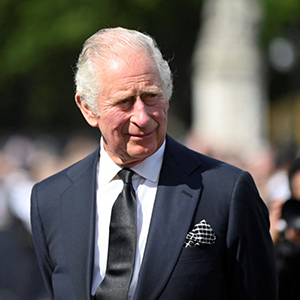
|
King Charles III 14th November 1948 - King Charles III, as the current monarch, continues the tradition of royal residence in iconic British castles, including Windsor Castle. |
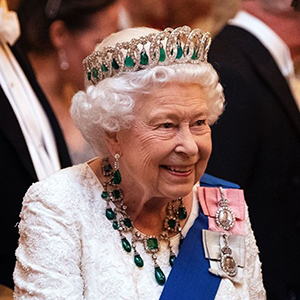
|
Queen Elizabeth II April 21st 1926 - September 8th 2022 Queen Elizabeth II maintained and modernised many of the United Kingdom's castles, ensuring their preservation and historical significance. |
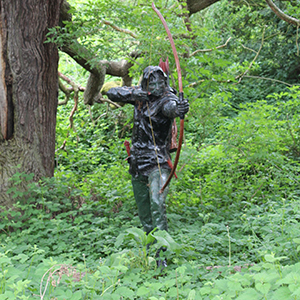
|
Robin Hood Unknown - legendary hero Robin Hood, a legendary outlaw, is often associated with Nottingham Castle, symbolising resistance against tyranny and the protection of the common people. |
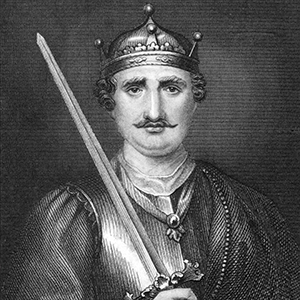
|
William the Conqueror c. 1028 - 9th September 1087 William the Conqueror, after his victory in 1066, began the construction of many castles across England, including the Tower of London, to establish Norman control. |
CAREERS
If children are interested in this topic, these are some possible jobs and careers that they might want to consider doing when they are older.
Also ask the children, "What other jobs could you do?" and "What do you like doing that could be part of a job related to ... ?"

|
Architect Architects are people who design big buildings, like castles and bridges. They draw plans to show how these places will look. |
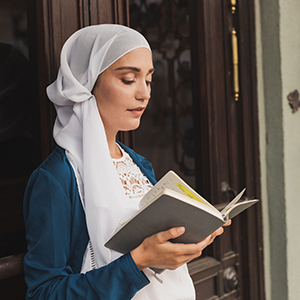
|
Historian Historians study the past and tell stories about old castles and bridges. They know a lot about kings, queens, and ancient battles. |
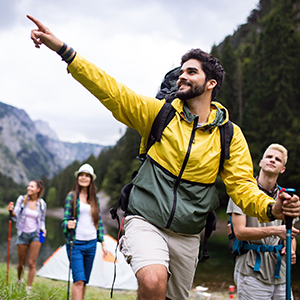
|
Tour Guide Tour guides help people learn about castles and bridges by leading them on fun adventures. They share cool facts about these places. |
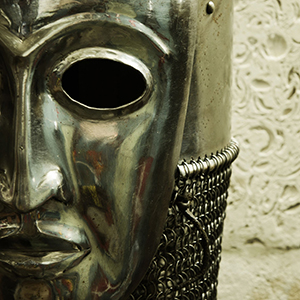
|
Museum curator Museum curators take care of important things like old swords, paintings, and even pieces of castles. They put them in museums so everyone can see. |

|
Structural engineer Structural engineers make sure buildings like castles don't fall down. They are experts at knowing how buildings stay strong. |
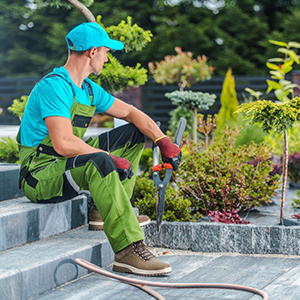
|
Landscape gardener Landscape gardeners make the land around castles and bridges beautiful. They design gardens and paths for people to enjoy. |
TEACHER INFORMATION
Castles
Castles are impressive structures with distinct architectural features, such as keeps, moats, drawbridges, gatehouses, battlements, and towers, all meticulously designed for defence. Keeps are central strongholds providing the last line of defence. Moats, often filled with water, surround the castle to deter attackers. Drawbridges can be raised to block entry across the moat. Gatehouses control access and add an extra layer of security. Battlements, the parapets on the top of castle walls, provide cover for defenders. Towers offer vantage points for surveillance and archery.
Primarily constructed during the Norman period following the Battle of Hastings in 1066, castles served as homes for nobility and formidable defensive strongholds. The Normans introduced the motte-and-bailey design, featuring a wooden or stone keep on a raised earthwork (motte) accompanied by an enclosed courtyard (bailey). Later, stone keep castles became more common, offering greater durability and improved defence capabilities.
Daily life in a medieval castle was complex, with distinct roles for its inhabitants. The lord oversaw the estate, managed resources, and provided justice. Soldiers, including knights, were responsible for the castle's defence and participated in warfare. Servants carried out essential tasks such as cooking, cleaning, and maintaining the castle. Knights, often of noble birth, provided protection and swore fealty to their lord. The people within the castle walls wore period-specific clothing, with the nobility donning elaborate garments and the lower classes wearing simpler attire. Their diet included foods like bread, meat, and vegetables, with the wealthy enjoying a more varied and abundant selection.
Different types of castles reflect the evolution of military architecture. Early Norman motte-and-bailey castles, with their wooden keeps and quick construction, were soon succeeded by more robust stone keep castles. Stone keeps, such as the Tower of London, provided better defence against attacks and the elements, becoming symbols of Norman authority and power.
Edinburgh Castle, perched on Castle Rock, is a historic fortress that has played a pivotal role in Scottish history. This stone keep castle, with its strategic location, has been involved in many conflicts and sieges. Today, it houses the Crown Jewels and the Stone of Destiny, important symbols of Scottish monarchy.
Windsor Castle, the longest-occupied palace in Europe, serves as both a royal residence and a working royal palace. Its impressive architecture includes a large keep, known as the Round Tower, and beautiful state apartments. Windsor Castle exemplifies the evolution of castle design from a defensive stronghold to a symbol of royal opulence and power.
Clifford's Tower, originally part of York Castle, is a prominent example of a Norman motte-and-bailey castle. The tower, built on a motte, served as a royal stronghold in the north of England. Its history includes roles as a defensive fortress, a royal mint, and even a prison.
Leeds Castle, known as the "Loveliest Castle in the World," has a rich history dating back to the 12th century. This picturesque castle, set on islands in a lake formed by the River Len, evolved from a Norman stronghold to a private residence. Its beautiful gardens and historic interiors attract numerous visitors each year.
Bridges
Bridges are vital structures that connect places separated by water or land, simplifying travel and fostering economic and social integration. At their core, bridges consist of three main components: decks, piers, and abutments. The deck is the horizontal surface on which vehicles and pedestrians travel. Piers are the vertical supports that hold up the deck, typically placed at intervals along the length of the bridge. Abutments are the structures at either end of the bridge that anchor it to the ground, providing stability and support.
Bridges can be built in various styles, including arch, beam, suspension, and cantilever. Arch bridges, such as the Iron Bridge in Shropshire, utilise a curved, semicircular structure that distributes weight evenly, allowing them to span considerable distances while supporting heavy loads. Beam bridges, like the Poohsticks Bridge, are the simplest form, consisting of horizontal beams supported at each end by piers or abutments, typically used for shorter spans. Suspension bridges, exemplified by the Clifton Suspension Bridge designed by Isambard Kingdom Brunel, feature decks hung below suspension cables on vertical suspenders, making them ideal for spanning large gaps. The Forth Rail Bridge in Scotland is a cantilever bridge, relying on cantilevers, which are horizontal beams supported only on one end, providing immense strength and rigidity, suitable for carrying heavy rail traffic.
The materials used in bridge construction have evolved over time, impacting their strength and durability. Ancient bridges often used wood and stone, such as those constructed by the Romans, which played a significant role in facilitating transportation and trade. As technology advanced, iron and steel became prominent, leading to stronger and more durable structures. The use of these materials allowed for the construction of iconic landmarks like the Tower Bridge in London, known for its unique design and historical significance.
Famous bridges, such as the Humber Bridge, one of the longest suspension bridges in the world, and the Tower Bridge in London, have become iconic landmarks. These structures not only serve functional purposes but also stand as symbols of engineering prowess and cultural heritage. Ancient bridges, such as those built by the Romans, were crucial in connecting distant parts of their empire, enabling efficient movement of people, goods, and armies, thus playing a significant role in the expansion and maintenance of their civilisation.
Robin Hood
Robin Hood is a legendary English folk hero, renowned for his skills as an archer and swordsman. He is traditionally depicted as a kind-hearted outlaw who "robbed from the rich and gave to the poor," operating in Sherwood Forest with his band of Merry Men, including notable figures such as Little John, Friar Tuck, and Maid Marian. The tales of Robin Hood are set in the medieval period, often during the reign of King Richard the Lionheart.
A significant part of the Robin Hood legend is centred around Nottingham and Nottingham Castle. Nottingham Castle, a royal fortress with a rich history, is often portrayed as the stronghold of the Sheriff of Nottingham, Robin Hood's main adversary. The castle played a crucial role in the tales, serving as the site of various skirmishes and daring rescues. Nottingham itself, a historic city, provides the backdrop for many of Robin Hood's adventures, highlighting the tension between the oppressive ruling class and the common folk.
Though historical evidence of Robin Hood's existence is scarce, his story has been a popular subject in literature, theatre, and film, symbolising the fight against injustice and tyranny. Robin Hood's enduring appeal lies in his representation of the struggle for social justice and the ideal of fairness, with Nottingham and its castle serving as iconic settings in the narrative.
Here are some common misconceptions about this topic:
Misconception: Castles were always made of stoneFact: Early castles were often made of wood and earth, and stone castles came later as fortifications improved.
Misconception: All castles had moats
Fact: Not all castles had moats; some relied on other forms of defence, such as thick walls and elevated positions.
Misconception: Castles were just for royalty
Fact: Castles were used by various members of the nobility, not just kings and queens, and served as military fortresses and administrative centres.
Misconception: Castles were always large and grand
Fact: Some castles were small and functional, serving primarily as military outposts rather than luxurious residences.
Misconception: All castles look the same
Fact: Castles vary widely in design and structure, depending on their location, purpose, and the time period in which they were built.
Misconception: Castles were always cold and dark
Fact: While some parts of castles could be drafty, many castles had fireplaces, tapestries, and other means to make them more comfortable.
Misconception: Castles were always used for defence
Fact: While defence was a primary function, many castles also served as homes, administrative centres, and symbols of power.
Misconception: Castles were built only in Europe
Fact: While Europe is famous for its castles, similar fortifications were built in Asia, the Middle East, and other parts of the world.
Misconception: Castles were built quickly
Fact: Building a castle was a lengthy process that could take several years or even decades to complete.
Misconception: Castles were abandoned after the Middle Ages
Fact: Many castles continued to be used and modified well into the Renaissance and modern periods for various purposes.
Misconception: Bridges were always made of stone
Fact: Many early bridges were made of wood, and stone bridges became more common as engineering techniques advanced.
Misconception: Bridges are only for crossing rivers
Fact: Bridges can span a variety of obstacles, including valleys, roads, and railways, not just rivers.
Misconception: All bridges are the same design
Fact: Bridges come in various designs, such as arch, suspension, and beam bridges, each suited to different types of crossings and engineering needs.
Misconception: Bridges never collapse
Fact: Historically, some bridges have collapsed due to structural failure, natural disasters, or other causes.
Misconception: Building bridges is quick and easy
Fact: Constructing a bridge is a complex process that can take years of planning and building.
Misconception: Modern bridges are made only of steel and concrete
Fact: While many modern bridges use these materials, some still incorporate wood, stone, and other materials.
Misconception: All bridges are built for vehicles
Fact: Bridges can also be built for pedestrians, trains, cyclists, and animals.
Misconception: Bridges are a recent invention
Fact: Bridges have been constructed since ancient times, with some early examples dating back thousands of years.
Misconception: Suspension bridges are the strongest
Fact: While suspension bridges are strong, other types, like arch and truss bridges, can also be incredibly sturdy and are better suited for different situations.
Misconception: Bridges do not need maintenance
Fact: Bridges require regular maintenance to ensure their safety and longevity, including inspections, repairs, and sometimes complete overhauls.
